#team photos 1967–1968
Text

Classic photo of Walt “Clyde” Frazier (right) and Earl “The Pearl” Monroe (left) in the 1970’s. Earl was drafted to the Baltimore Bullets in 1967 being the second overall pick. He had an arsenal of moves in his bag. Earl was also a dazzling ball handler and a crowd favorite. He was a good scorer as well. Earl will always be a true legend in my book….”The Pearl”!
Career: (1967-1980) Bullets, Knicks
Per: 18.8 ppg 3.0 rebs 3.9 asts
-4x allstar
-1967-1968 All-rookie
-1967-1968 Rookie of the year
-1968-69 All-Nba
-1973 NBA Champ🏆
-75th Anniversary team
-Hall of Fame🧥
#blacktumblr#black history#black liberation#african history#earl monroe#walt frazier#nba players#hall of fame
42 notes
·
View notes
Photo

It is easily arguable that the most significant technique change in athletics was high jumping’s “Fosbury flop”. Dick Fosbury, who has died aged 76, invented the eponymous unconventional way of getting over the bar. In the words of the American coach John Tansley, “he literally turned his event upside down”, but besides the sport, the flop’s impact as a paradigm change was even more remarkable.
For millennia, humans had proceeded over obstacles in their paths one foot at a time. Even as the sport of athletics was refined, high jumpers basically followed the techniques of hurdlers and steeplechasers without considering that they, unlike those runners, did not have to continue to propel themselves forward after their jumps. The early “scissors” technique was essentially a hurdle of the bar; the later techniques, the “straddle” and various rolls, looked the way their names implied. High jumpers preceding Fosbury were tall but strong, like sprinters, in the upper body.
The “flop” – which you can see hints of in the twisting rolls of great jumpers who preceded him, Charlie Dumas, John Thomas or Valeriy Brumel – did not come to Fosbury in a “eureka” moment, but as he tinkered with his traditional technique while still at high school in the early 1960s. He found himself moving his body more and more sideways, until finally he was jumping with his back to the bar, body parallel to the ground, and legs perpendicular to it. As his head and torso went over, he would kick his legs high, landing face up on his shoulders. The jump began to describe a parabola.
Despite his coach’s scepticism, the results were evident, and when a photo in the local paper was captioned “Fosbury Flops Over Bar”, the jump had acquired its name. Finishing second in the 1965 Oregon state championships as a senior, he jumped 6ft 5 ½in, fractionally under two metres.
There were others out there developing their own versions, notably the Canadian Debbie Brill, who, aged 17, won Commonwealth Games gold in 1970 at 17 using the “Brill bend”. Those innovators were aided by a small but significant development: high jumpers had always landed, on their feet or on hands and one foot, in pits of sand or sawdust; during the 60s, mats filled with foam rubber started to replace pits. As Dumas, who in 1956 became the first man to clear 7ft, explained in a 1986 interview, “I couldn’t have mastered [the flop]; I just didn’t have the range of motion. On the other hand, the floppers could never have jumped 7ft 8 or 9in and landed in sawdust pits like we did; they could break their necks.”
At Oregon State University, Fosbury’s college coach tried to switch him back to the “western roll”, but agreed to let him use the flop in his freshman team meets. In 1967, he broke the school record with a 6ft 10in (2.08m) leap; all talk of western rolls disappeared. The next year, he won his first of two national college titles clearing 7ft 2½in, then won the US Olympic trials in Los Angeles. But Olympic officials, afraid the flop would not work in the altitude of Mexico City, where the summer 1968 Games were to be held, scheduled a second trial above sea level. He scraped in as the third of three qualifiers, all clearing 2.20m, but Fosbury having more misses.
In Mexico City, he won his gold medal, the only jumper to clear an Olympic record 2.24m after a gruelling competition; he failed at three attempts to break Brumel’s world record of 2.28m. The Olympics introduced the Fosbury flop to the world, and showed fellow jumpers film of the style; previously most had seen only photos. By the time Munich staged the games in 1972, 28 of the 40 jumpers were “flopping”.
Born in Portland, Oregon, Fosbury grew up in Medford, where his father, Doug, drove a lumber truck and his mother, Helen (nee Childers), worked as a secretary and was a concert pianist. Fosbury grew tall (6ft 4in) but was not strong, weighing only around 13 stone throughout his career, and had been cut from his high school’s basketball and gridiron teams before finding his way into athletics.
He never equalled his performance in Mexico City and never broke the world record; Brumel’s mark fell to the American Pat Matzdorf, who cleared 2.29m, still using the straddle. But in 1973, Dwight Stones, who had watched Fosbury in Mexico as a 14-year-old, became the first world record-holding flopper at 2.30m, and virtually all jumpers since have flopped. The current world record is 2.45m, set by Cuba’s Javier Sotomayor in 1993.
Following Mexico, Fosbury returned to Oregon State, won his second NCAA title in 1969 and finished his civil engineering degree while competing on the amateur circuit. As more athletic jumpers adopted his technique, he failed to make the US team for the 1972 Munich Olympics. He joined the short-lived professional international track association tour in 1973, then retired and moved to Ketcham, Idaho, and set up a firm specialising in bike and running trails. He became a motivational speaker and author of books such as The Fosbury Flop: A New Philosophy for Success, and Leap of Faith: Overcoming Obstacles and Achieving Success.
He was also a vice-president of the US Olympic Association, served as a county commissioner, and ran unsuccessfully for Congress as a Democrat in conservative Idaho.
In 2008 he was diagnosed with lymphoma in his lower vertebrae; after spinal surgery and chemotherapy, the cancer went into remission. From 2011 to 2019 he served as president of the non-profit World Olympians Association.
With his third wife, Robin Tomasi, whom he met in a swing-dancing class, Fosbury ran a horse farm in Bellevue, Idaho. His first marriage, to Janet Jarvis, and second, to Karen Thomas, both ended in divorce; he is survived by Robin, by a son, Erich, and two stepdaughters, Stephanie and Kristen, from his second marriage, and by a sister, Gail.
🔔 Dick (Richard Douglas) Fosbury, high jumper, born 6 March 1947; died 12 March 2023
Daily inspiration. Discover more photos at http://justforbooks.tumblr.com
16 notes
·
View notes
Text
tuesday again no problem 12/20/22
feelin...fizzy. feelin...scattered. let's make up for it with twelve (12) photos and a three part making section
listening
unloved’s new album has been out for some weeks but ive had Sorry, Baby on loop most of that time. it’s got the sort of fluttery bubbly electronica i associate with heist scenes or when someone wants to convey there is technology bubbling away in the background. cf a lot of the ambient music for the fallout 4 nuka cola world dlc. i also wish i had a better comparison.
youtube
-
reading
fallow weeks. it’s so funny how mack’s face changes in different light. she has such an angular teen face right now but you would not know it from this photo where she has eyebrows.
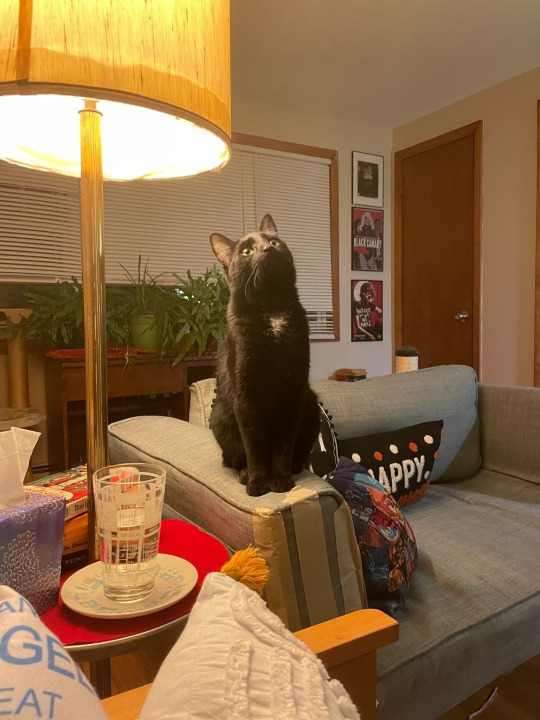
-
watching
rewatching a bunch of westerns as i knit. even tho i rarely rewatch shit, i want to be steeped in the vibes bc the days are very short and the nights are very long and the cowboys spark joy. The Great Silence (1968, dir. Corbucci) knocked me flat for a full twelve hours as it did for my first viewing. i remain mildly bemused by Death Rides A Horse (1967, dir. Petroni) but im glad mr van cleef got to have his tits out?
i also saw Gallowwalkers (2012, dir. Goth, starring Wesley Snipes). a weird west/horror sort of direct to DVD thing. there is very little to recommend this movie. it is largely incoherent. it has a lot of on-screen rape and sexual assault and women getting thrown around. i could not put together this movie in chronological order if you put a gun to my head. however, it does Look.


the costuming is what i can only call “capcom video game”. some of the worst wigs i have ever seen in my life are in this movie.
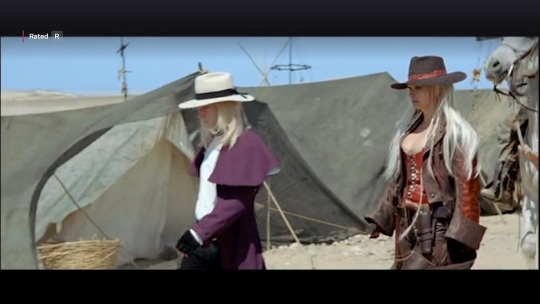

yes this man has two iguanas sewn to his head, bc the schtick of the film is the undead need to continuously get new skin sewn on. how they acquire the skin is shown in great detail.
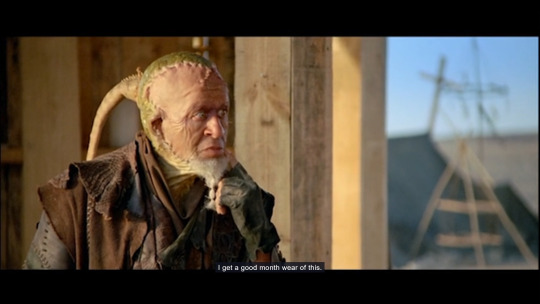
unfortunately (fortunately?) the baddies have nearly all the good lines.

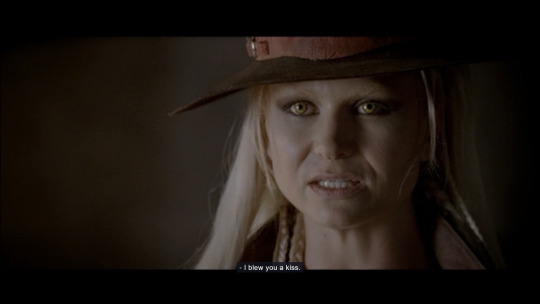

-
playing
beat the elite four in Pokémon, beat Team Star, beat Arven (that sucked. i felt so bad at the end of that) can’t quite beat my best friend/arch rival. more puttering around needed. or perhaps i need to actually learn how types work instead of hitting everything with one of my flamingo’s three different kinds of big kick. let me in the crater!!!
-
making
knitting again!!! i will update when i have a full repeat done bc right now it doesn’t look like very much. beloved mutual and real/life co-conspirator @itsybitsydragon passed along two gently loved cat trees for my chief henchwoman and she (the cat) has taken to them quite well!!! lovely to see her (my dear friend, i can see my cat any time i want), very worth shuffling a lot of furniture around.

I did promise a cast iron update but it’s a disappointing and slightly baffling update. this is Four (4!))) layers of seasoning and it's still not evening out. it's covered, bc it's not rusting, but it does look like fucking shit. it is dry to the touch and not tacky.
there are several potential causes, i think:
couldn’t quite get all the old seasoning off and this is somehow affecting the new seasoning (but it shouldn't be reacting this weirdly to the flaxseed oil? or really at all?)
i didn’t manage to completely neutralize the vinegar bath with baking soda?
the layers are maybe slightly too thick or slightly too thin? the weirdest looking parts are in the parts where i did manage to get the old seasoning off and down to bare metal
perhaps my ancient electric oven is not quite getting up to that nice 450-500F i want? i inadvertently left my oven thermometer in the old lair and haven't remembered to get a new one, but the smoke point of this oil should be like 225-230F, and i know for a fact my oven gets above that bc i have not yet given myself food poisoning


this is probably perfectly fine and safe to cook with but it's a little bit too much problem solving for me right now, and like @morrak i'm probably going to get deeply annoyed at some point and have at it with some naval jelly. unfortunately that will have to wait for more clement weather.
26 notes
·
View notes
Text
5 Times U.S. Presidential Commissions Rocked the Country
What Do a Long List of Iconic and Controversial Historical Events Have in Common? They All Got The Presidential Commission Treatment.
— May 14, 2024 | Kirstin Butler

President Kennedy rides in his motorcade minutes before his assassination in Dallas in 1963. Bill Waterson/Alamy Stock Photo.
A presidential assassination. Widespread racial protest. Pearl Harbor. The high-profile explosion of a space shuttle. Highly disparate topics, but in each case, a U.S. president was moved—whether by public pressure or their own conscience—to call for a special panel investigating the causes and treatments of a pressing issue.
Presidential commissions are tasked, often under heightened political and time constraints, with explaining complex societal dynamics and events. Sometimes those analyses are heeded; other times, as with President Lyndon B. Johnson’s Kerner Commission, deliberately ignored. And yet in each instance, the formation of a task force appointed to directly advise the president sends an unmistakable public message as to a problem’s significance. Here are five of the 20th century’s most iconic presidential commissions.

President and Mrs. Kennedy and Texas Governor John Connally and his wife ride in the motorcade in Dallas, November 22, 1963. Victor Hugo King/Library of Congress.
Warren Commission
One week after President John F. Kennedy was shot to death in Dallas, Texas, his successor Lyndon Johnson appointed a commission to investigate both Kennedy’s murder and the killing of Lee Harvey Oswald, the president’s alleged assassin. Led by Supreme Court Chief Justice Earl Warren, the commission received testimony from 550 witnesses and 3,100 reports from the FBI and Secret Service.
Nearly 10 months after the task force was formed, the commission submitted its 888-page report to President Johnson, which was subsequently made public along with 26 volumes of supporting documents. The report’s central finding—that Oswald acted alone in Kennedy’s killing, absent any national or international conspiracy—has been the focus of intense speculation and criticism in the years since its release. “As long as a mystery resides at the center of this case, it can't be closed,” investigator Josiah Thompson told American Experience. “There's this fundamental question mark that still stands there in the center of our experience in the 20th century.”

President Lyndon Johnson (Seated, Center) shakes hands with members of the Kerner Commission. July 29, 1967. White House Photo Office Collection, LBJ Presidential Library.
Kerner Commission
The second bombshell commission of Johnson’s presidency, the National Advisory Commission on Civil Disorders—known colloquially as the Kerner or Riot Commission—was established in July 1967 following several years of urban civil uprisings across the United States. Johnson asked his task force to address three questions: “What happened? Why did it happen? What can be done to prevent it from happening again and again?”
Johnson appointed the Democratic governor of Illinois Otto Kerner as the bipartisan commission’s chair, and its field teams undertook a rigorous, on-the-ground investigation in 23 cities to try to understand the root causes of unrest that led to violence, arson and looting. The conclusion the commission members came to was shocking for its time. “White society is deeply implicated in the ghetto,” their 1968 report plainly stated. “White institutions created it, white institutions maintain it, and white society condones it.” President Johnson was so dismayed that he refused to publicly acknowledge the final report, which nonetheless went on to become a national bestseller.
“The commissioners did not deign to take the easy way out,” said New Yorker journalist Jelani Cobb. “They had the vantage point of having actually seen the conditions with their own eyes, having gone to places and talked to people and come as close as they could to experiencing life in these ghettos. They told the nation what exactly the problem was, even if it meant that no one was going to listen to them.”
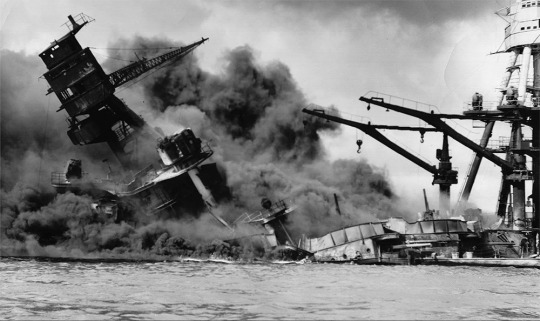
A U.S. battleship sinking during the Pearl Harbor attack. National Archives.
Roberts Commission
After the shocking Japanese attack on Pearl Harbor on December 7, 1941, President Franklin D. Roosevelt called for an investigative task force to determine if negligence or dereliction of duty on the part of military and government officials had enabled the attack. Chaired by Supreme Court Justice Owen J. Roberts, the commission was made up entirely of active or retired military officials. The investigation began in Washington, D.C. and proceeded to Honolulu, interviewing 127 witnesses. Less than two months after the surprise bombing—an extremely fast turnaround for such a significant event—the commission released its findings.
Roosevelt’s task force assigned blame chiefly to Admiral Husband E. Kimmel and Lieutenant General Walter C. Short, the U.S. military’s top army and navy commanders in the Pacific, both of whom were demoted, while exonerating several prominent political figures. The commission’s final report never specifically mentioned Japanese Americans, but a passage about “Japanese spies” received widespread media coverage, and played a critical part in turning mainstream American public opinion in favor of incarcerating U.S. citizens of Japanese descent. California’s governor confirmed the connection, saying of many of his constituents at the time, "Since the publication of the Roberts Report, they feel they are living in the midst of enemies. They don't trust the Japanese, none of them.’”
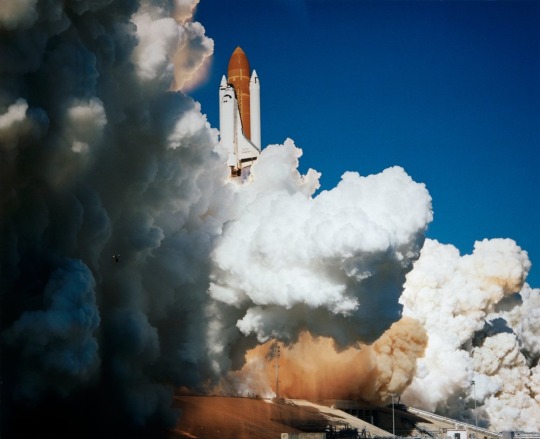
Challenger lifts off on Jan. 28, 1986 with a crew of seven astronauts. An accident 73 seconds after liftoff claimed both crew and vehicle. NASA.
Rogers Commission
On January 28, 1986, the space shuttle Challenger exploded 73 seconds after its launch in Cape Canaveral, Florida, a disaster broadcast on live television. NASA immediately halted the shuttle program, and President Ronald Reagan appointed a fact-finding commission chaired by former Attorney General and Secretary of State William Rogers to determine the disaster’s cause. Prominent public figures were named commission members, including astronauts Neil Armstrong and Sally Ride, pilot Chuck Yeager and physicist Richard Feynman.
Extensive commission hearings revealed both mechanical and process failures leading to the explosion. Icy conditions on the day of the shuttle’s launch compromised rubber “O ring” seals on one of the shuttle’s rocket boosters during the extreme conditions of takeoff; during one commission session Feynman spectacularly demonstrated the seal failure by plunging an O ring into a glass of ice water. Following testimony that revealed space agency managers were aware of technical problems for years prior to the Challenger mishap, the commission also faulted NASA for poor engineering and management. The explosion, read the commission’s final report, was “an accident rooted in history.”

Admiral James Watkins hands President Reagan the report of the presidential commission on the HIV epidemic. James D. Parcell/The Washington Post via Getty Images.
Watkins Commission
In June 1987, Reagan called for the formation of another fact-finding mission, this one significantly more politically charged than the Challenger’s. The purpose of the Presidential Commission on the Human Immunodeficiency Virus Epidemic, Reagan said, was to make HIV go “the way of smallpox and polio.” Among the commission members were both Cardinal John O’Connor and gay medical researcher Frank Lilly; the latter’s appointment drew strong criticism from conservative quarters.
Almost immediately the task force ran into strong ideological and personal differences, leading its chair, vice chair, and only medical staff officer to quit three months in. In a surprise development, however, Reagan promoted an unlikely commission member to be the group’s new chairman. Admiral James D. Watkins, who had served as the U.S. Navy’s top ranking officer and a nuclear strategist, took over amid uncertainty about the panel’s effectiveness. Under his leadership, the commission strongly advised passage of anti-discrimination legislation for HIV patients, more equitable and affordable care, preventative treatment of IV drug use, and a loan program to encourage nurses to serve in communities highly impacted by the virus, among other recommendations. The commission’s final report ultimately called for a $20 billion, 10-year effort to combat the public health crisis. “It’s only seven-tenths of a percent of the defense budget,” Watkins reasoned.
0 notes
Text
Norman freeman

#Norman freeman movie#
#Norman freeman series#
#Norman freeman tv#
#Norman freeman tv#
The show was the top-rated TV show from 1971-1976. That same year, Lear and Yorkin produced All in the Family, which premiered on CBS.Norman Lear sent this photo of himself in uniform to his Emerson College classmates in 1944. In 1971, Lear made his directorial debut with Cold Turkey, starring Dick Van Dyke.Lear received an honorary Doctor of Humane Letters from Emerson College in 1968.Lear would take his older daughters to dinner dances at the Biltmore Los Angeles, something he sorely misses.In 1967, Lear earned an Academy Award nomination for Best Screenplay for Divorce American Style, a film he wrote and produced.In 1963, Lear and Bud Yorkin produced their first film together, titled Come Blow Your Horn.This was his first time serving as producer for a TV pilot. In 1961, Lear produced Band of Gold on CBS.
#Norman freeman series#
Produced by Revue Studios, the Western series starred Henry Fonda.
Lear created his first television series, The Deputy, in 1959.
Lear teamed up with Bud Yorkin to found Tandem Productions in 1959.
One of the first times Lear wrote for a project alone was in 1957, for The Tennessee Ernie Ford Show.
At a farewell party at writer Bud Yorkin’s house before NBC’s comedy shows were set to move from New York to LA, Lear, writing partner Ed Simmons, Yorkin, and guests wrote a song celebrating the laying of the transcontinental coaxial cable – the communications system making the move possible.
Although the program was quickly canceled, the opportunity gave Lear the platform to transition to producer of NBC’s The Martha Raye Show in 1955.
In 1954, Lear began writing for Honestly, Celeste! a CBS sitcom created by Celeste Holm.
#Norman freeman movie#
Lear received his first screenwriting credit in 1953 for his contributions to Scared Stiff, a horror movie about a nightclub singer and a busboy who run to a Caribbean island after being charged with murder.Beginning in the 1950s, Lear and Ed Simmons, his cousin Elaine’s husband, began writing comedy sketches for Martin and Lewis on the Colgate Comedy Hour, where they each received a record-breaking $52,000 for five episodes of content.In 1951, Lear became a staff writer for NBC’s Ford Star Revue, a variety and comedy show.So all I wanted was to grow up to be a guy who could flip a quarter to a nephew.”Ī teenage Norman Lear in a photo from his Emerson College application. He was a press agent so I wanted to be a press agent. “My dad had a brother, Jack, who flipped me a quarter every time he saw me. In an interview in 2009, he revealed that his Uncle Jack influenced this career choice. After he was discharged from the Army in 1945, Lear pursued a career in public relations.Lear flew a total of 52 combat missions and was awarded the Air Medal with four Oak Leaf Clusters for his service.He also was a radio operator/gunman on Boeing B-17 Flying Fortress vehicles. In the army, Lear was part of the 772nd Bombardment Squadron in the Mediterranean Theater of Operations.“I miss normality and Emerson (though I hardly mean to imply the two are in any way connected).” While training for the Army at the University of Buffalo, Lear “organized a Band, Orchestra, Glee Club and took over the Detachment Newspaper,” he wrote to his Emerson classmates.Lear left Emerson in 1942 to join the United States Army Air Force during World War II.Lear studied theatre at Emerson and was in Gertrude Binley Kay’s drama class when he learned that Pearl Harbor had been bombed.While at Emerson, Lear lived in an all-male boarding house on Clarendon Street in Boston.In a 2016 interview with Emerson Today, nearly 75 years after he left college, Lear sang Emerson’s school song – in tune.The winning speech he delivered, “The Constitution and Me,” detailed what the Constitution meant to Lear as a Jewish person. He was able to attend, he has said, after he won an American Legion oratory scholarship. After graduating from Weaver High School in Hartford, Connecticut in 1940, Lear attended Emerson College.“And that was my option: sink or swim,” he said. When Lear lived with his uncle in New Haven he read Horatio Alger’s Sink or Swim, which he claims inspired him to overcome difficulties in his life.He grew up in a Jewish household, and had a Bar Mitzvah.Norman Lear was born on Jin New Haven, Connecticut.To celebrate, Emerson Today compiled a list of facts about Lear – one for each year of his remarkable life. On July 27, 2022, Norman Lear ‘44, one of Emerson’s most illustrious alumni and the person who arguably did more than anyone else to shape television in the 20th century, turns 100.

0 notes
Text
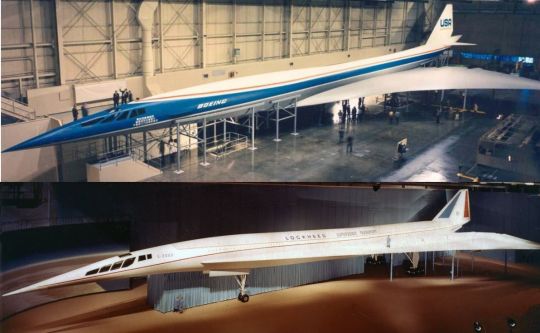
-Mockups of the two final American SST concepts, the Boeing 2707 and the Lockheed L-2000. | Composite Photo: Justin Gibb
FLIGHTLINE: 136 - AMERICAN SST PROGRAM
Various programs to develop a supersonic transport in the US stretched from the middle 1950s until the early 1970s, but no aircraft ever resulted.
The first recorded supersonic flight (the speed of sound is 767mph at 20°C/68°F at sea level) was on 14 October 1947, when the American X-1, piloted by Chuck Yeager, reached Mach 1.06. By the 1950s, supersonic flight became a more regular occurrence, though it was still almost exclusively restricted to military pilots. Around this time, various projects around the world began to develop airliners that could break the sound barrier too. Designs like the Sud Aviation Super-Caravelle and Bristol Type 223 were sketched, but technical limitations as well as a lack of funding stalled those efforts.
♫NINETY MINUTES FROM NEW YORK TO PARIS♫
Research continued however, and by the early-1960s a new round of programs were started, with BAC (later BAe and BAE Systems) and Sud Aviation (later Aérospatiale and Airbus) joining forces to produce what became Concorde, while the Soviet design bureau Tupolev developed the Tu-144 (NATO reporting name "Charger"). Numerous American carriers placed orders for Concorde aircraft, but spiraling costs and a desire to develop a domestic SST saw those orders canceled in the early 1970s. In the end, only Air France and BOAC/British Airways operated Concorde, while the Tu-144 was exclusively flown by the Soviet state airline Aeroflot.
BUY AMERICAN!
The FAA estimated in the early 1960s that there would be a market for 500+ SSTs by the year 1990. Fearing Anglo-French domination of the airline industry, the US Congress began funding various research programs, and President John F Kennedy announced a National Supersonic Transport program on 5 June 1963. Requests for proposals were sent to Boeing, Lockheed, and North American for the airframes; and Curtiss-Wright, General Electric and Pratt & Whitney for engines. The request stipulated a cruise speed of Mach 3, and a passenger capacity of up to 300. Preliminary designs were submitted on 15 January 1964
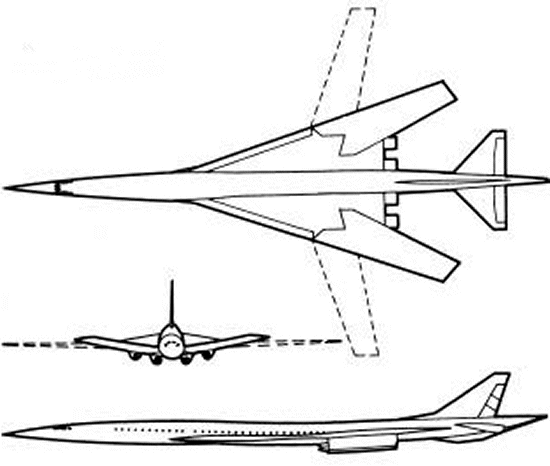
-Line drawing of the Boeing 733-790 SST, which initially featured swing wings. | Illustration: Boeing
The Boeing 733 model featured a large blended wing root with variable geometry outer panels, resembling an enlarged Rockwell B-1. The proposal included optional fuselage extensions, potentially increasing capacity to 227 passengers.

-Line drawing of the the CL-823. | Illustration: Lockheed Corp.
Lockheed's CL-823 was functionally an enlarged Concorde, though the wing shape was a cranked arrow rather than Concorde's ogival delta.
The North American NAC-60 was the smallest and slowest of the competitors, potentially transporting 187 passengers at Mach 2.65.
In 1965 the FAA downselected the NAC-60 design, as well as Curtiss-Wright's engine work, freeing up funds for Boeing and Lockheed on the airframe side and P&W and GE for the engine development.
TIME TO SHARPEN YOUR PENCIL.
The FAA scheduled a final selection in 1966, and requested detailed proposals from Boeing and Lockheed. Boeing had gone through several iterations of the Model 733, with the 733-390 being presented in September 1966. The aircraft was one of the first wide-body airliners, with 2-3-2 seating. In the 30-seat first class section, small tv's were to be integrated into a console between the seats, while in the 247-seat tourist class section larger retractable tv's would drop from the overheads every six rows. Externally, the engine pods had been moved back under the tail, and the wings, when swept back, would form a delta with the tail.
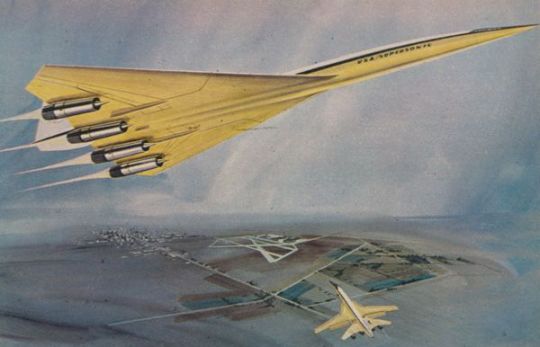
-Illustration of the 733-390, with one at maximum sweep and one at minimum. | Illustration: Boeing.
Lockheed's CL-823 had evolved as well, with the L-2000-1 design having changed from a cranked arrow to a delta wing, with the engines separated into individual pods. In order to speed production, the L-2000 was projected to use a derivative of the J58 engine that had powered the A-12 OXCART and SR-71 Blackbird. New requirements from the government saw changes to the wing and fuselage, and the engine pods were redesigned to accommodate either the P&W JTF-17A or GE4 designed as part of the SST program. The final design presented to the FAA was the L-2000-7A/B (the B was 20 feet longer), which had a passenger capacity of 230.

-Advertising image of the L-2000-7A. | Illustration: Monsigneurhulot
THE FINAL SHOWDOWN
The final designs, complete with full-scale mockups, were presented in September 1966.

-The full-scale mockup of the 733-390, in a striking white-over-yellow paint scheme. The size of the plane is evident from the man standing near the third jack. | Photo: Boeing

-Appearing no less impressive, the Lockheed L-2000 mockup. | Photo: Lockheed
FAA review of the competing SSTs took until December, with the Boeing design being announced the winner on 1 January 1967. The L-2000 was judged to easier to produce, but it was also thought to be less risky and advanced than the Boeing entry, and thus the latter was more in the spirit of the design mandate. Also, the Lockheed craft was anticipated to be louder with the JTF-17A engines, as well as being slower.
Boeing anticipated construction of the 733-390 prototypes, now referred to as the 2707-200, would begin in 1967, with first flight in 1970. Construction of the production models was expected to commence 1969, with first flight in 1972 and FAA certification anticipated by 1974.

-The public enthusiasm for the SST program was initially high, with scale models and toys of the design being release by multiple companies. Seattle's NBA team, formed in 1967, was initially named the SuperSonics. | Photo: oldmodelkits.com
NO PLAN SURVIVES FIRST CONTACT WITH THE ENEMY (IN THIS CASE, PHYSICS)
Almost immediately, Boeing began encountering problems with the design. Canards were added to improve flight characteristics, but this added weight. The swing wing mechanism were also much heavier than anticipated, with one pivot section being an eleven feet long, two-and-a-half feet thick piece of titanium weighing 4,600lbs. All of this added weight was eating into the plane's range and lowering the speed, and in October 1968 the company made the decision to delete the variable geometry wings and utilize a fixed delta instead. Fabrication of a mockup of the new design, the 2707-300, as well as two prototypes, commenced in September 1969. Despite these issues and delays, by October 1969 Boeing had orders for 122 2707s from 26 airlines, including Alitalia, Canadian Pacific Airlines, Delta Air Lines, Iberia, KLM, Northwest Airlines, and World Airways.
It was during this period however than organized opposition to SSTs became more pronounced. During the first half of 1964, the FAA conducted Operation Bongo II, under which Oklahoma City, Oklahoma was subjected a total of 1,253 sonic booms. Up to eight booms were scheduled, beginning at 7am and ending in the afternoon. Various aircraft were used, from fighters like the F-104 to bombers like the B-58 and XB-70. The results of the experiment were encouraging, with only 9,594 complaints of damage to buildings, 4,629 formal damage claims, and 229 claims for a total of $12,845.32 ($108.983.34 in 2021). 73% of subjects in the study said that they could live indefinitely with eight sonic booms per day, while 25% said that they couldn't. Approximately 3% of the population filed complaints or lawsuits. The FAA's handling of the program and response to the claims completely undid the public's acceptance of supersonic flight however. The program was undertaken with minimal engagement of the local authorities, and afterwards the FAA dismissed 94% of the claims received, attracting the ire of state and national leaders. Class action lawsuits were filed against the government, and public opinion turned against the SST. This culminated in a national ban on supersonic flight over land. Another source of concerns was the exhaust from the jet engines, specifically nitrogen oxides, which were found to damage stratospheric ozone. A fleet of 500 SSTs was calculated to cause a drop in ozone of 1 to 2%, though changes in fuel and engine technology would help mange this.
THE COLLAPSING STAGE...
The mounting environmental concerns, souring public perception, continuing technical hurdles and competing projects saw the funding for the SST program drying up. Both the House and Senate voted in 1971 to end funding for the program, spelling the end of American SST. Whatever work completed on the prototypes was dismantled, and the one completed 2707-300 mockup was sold to the SST Aviation Exhibit Center in Florida, which displayed it from 1973 until 1981. Hard times saw the closure of the museum, which was then sold to the Faith World Church in 1983. For the next seven years, the Osceola New Life Assembly of God held services beneath the wing of the only remaining example of the US' supersonic airliner program.
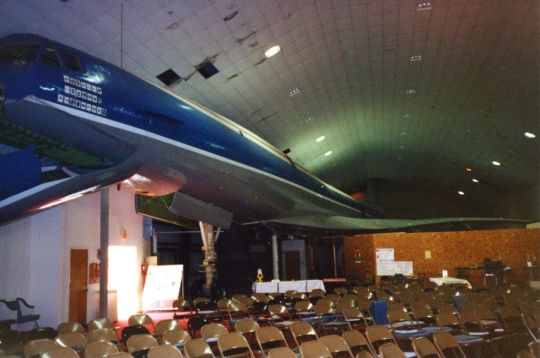
-The 2707 mockup some time in the 1980s. Sunday school classes were held under the port wing for nearly a decade. | Photo: Boeing
In 1990 the remnants of the mockup were sold to Stan Hiller, helicopter pioneer and owner of the Hiller Aviation museum. In 2013 the forward 90' section of the fuselage, now all that remained, were shipped to the Museum of Flight was part of a transfer between the two museums. What's left of the 2707-300 is now under restoration; the last remnants of a grand dream to move air travel forward at Mach 3.

-The remaining segment of the 2707, now 50 years after the program's termination. | Photo: Boeing
#aircraft#aviation#avgeek#airplanes#airplane#cold war#cold war history#coldwar#usaf#aviation history#sst#seattle supersonics#supersonic jet#supersonic transport#supersonic airliner#Boeing#Lockheed#the 60s#the 70s#the sixties#the seventies#faa#air travel#Concorde#boac#air france#Tupolev#tu-144#tu 144#concordeski
95 notes
·
View notes
Note
He's not my favorite in a normal sense. His crazy fucking lifestyle and death are. He knew Elvis, The Rolling Stones, and many others too. Here's a mini bio on him:
Ingram Cecil Connor III better known professionally as Gram Parsons. He was a musician and frontman. Parsons worked with The Byrds in 1968, before quitting and joining his own band, The Flying Burrito Brothers from 1969 through 1970.
Gram was born in Winter Haven, Florida on November 5th, 1945 to Ingram Cecil Connor Parsons II and Avis Snively Connor. Avis returned to her hometown to give birth to her son. She was the daughter of citrus fruit magnate John A. Snively, who held extensive properties in Winter Haven and in Waycross. Gram's father, Ingram Connor II was a famous World War II flying ace, decorated with the Air Medal, who was present at the 1941 attack on Pearl Harbor.
In 1956 when he was only nine-years-old, Gram saw Elvis Presley in concert and fell in love with music. That’s where his love of music came in. Two years later his father who went by “Coon Dog” took his own life two days before Christmas, Gram was only 11/12. Both him and his sister Avis (Jr) were both shattered after their father’s death.
Avis Sr remarried to Robert Parsons and the children took his name and were adopted by him once he married their mother.
Gram Parsons did briefly attend the prestigious Bolles School in Jacksonville, Florida. That was before transferring to the public Winter Haven High School. Which he did after failing his junior year. Gram returned to Bolles which had converted from a military to a liberal arts curriculum amid the incipient Vietnam War.
For a time, the family found a stability of sorts. They were torn apart in early 1965, when Robert had an extramarital affair and Avis' heavy drinking led to her death from cirrhosis on June 5, 1965, the day of Gram's graduation from Bolles.
Barely in his teens, he played in rock and roll cover bands such as the Pacers and the Legends, headlining in clubs owned by his stepfather in the Winter Haven/Polk County area. By the age of 16, he graduated to folk music, and in 1963 he teamed up with his first professional outfit, the Shilohs, in Greenville, South Carolina.
Gram was heavily influenced by The Kingston Trio and The Journeymen. The band played hootenannies, coffee houses and high school auditoriums. Parsons was still enrolled in prep school, he only performed with the group in select engagements. Forays into New York City (where Parsons briefly lived with a female folk singer in a loft on Houston Street)included a performance at Florida's exhibition in the 1964 New York World's Fair and regular appearances at the Café Rafio on Bleecker Street in Greenwich Village in the summer of 1964.
Although John Phillips who is an acquaintance of Shiloh George Wrigley arranged an exploratory meeting with Albert Grossman, the impresario balked at booking the group for a Christmas engagement at The Bitter End when he discovered that the Shilohs were still high school students. Following a recording session at the radio station of Bob Jones University, the group reached a creative impasse amid the emergence of folk rock and dissolved in the spring of 1965 around the time of Gram’s mother’s passing.
Shockingly despite being poor in school and having bad test grades, Gram went to Harvard University in 1966 with the help of a strong essay he wrote. He only did one semester and that’s where he became more serious about country music. He heard Merle Haggard for the first time.
In 1966, he and other musicians from the Boston folk scene formed a group called the “International Submarine Band”. After briefly residing in the Kingsbridge section of the Bronx, they relocated to Los Angeles the following year. Following several lineup changes, the band signed to Lee Hazlewood's LHI Records, where they spent late 1967 recording Safe at Home. The album contains one of Parsons' best-known songs, "Luxury Liner", and an early version of "Do You Know How It Feels", which he revised later in his career. Safe at Home would remain unreleased until mid-1968, by which time the International Submarine Band had broken up.
In that same year Gram got the attention of The Byrds’ guitarist Chris Hillman thanks to business manager Larry Spector as a possible replacement member since David Crosby and Micheal Clarke left in late 1967. Parsons had already met Hillman at a bank in 1967. Gram had his only child, Polly, with Nancy Ross the girlfriend of David Crosby.
Gram passed the audition in February 1968. He was at first a jazz pianist but was switched to rhyme guitar and vocals. Gram left the band when asked why Gram responded with,
"Being with The Byrds confused me a little. I couldn't find my place. I didn't have enough say-so. I really wasn't one of The Byrds. I was originally hired because they wanted a keyboard player. But I had experience being a frontman and that came out immediately. And [Roger McGuinn] being a very perceptive fellow saw that it would help the act, and he started sticking me out front."
He was also friends with The Rolling Stones members Mick Jagger and Keith Richards. And they stayed close to each other until a fall out in the 70s. Before Parsons' departure from The Byrds, he had accompanied the two Rolling Stones to Stonehenge along with McGuinn and Hillman in the English county of Wiltshire.
Immediately after leaving the band, Parsons stayed at Richards' house and the pair developed a close friendship over the next few years, with Parsons reintroducing the guitarist to country music. According to Stones' confidant and close friend of Parsons, Phil Kaufman, the two would sit around for hours playing obscure country records and trading off on various songs with their guitars.
Returning to Los Angeles in 1969, Parsons sought out Hillman, and the two formed The Flying Burrito Brothers with bassist Chris Ethridge and pedal steel player “Sneaky” Pete Kleinow. They did every genre of music possible from hard rock all the way to country and jazz gospel. Around this time of The Flying Burrito Brothers, Gram started dabbling more and more into drugs.
Then Gram started a solo career in 1970 and toured with Emmylou Harris for a bit ; he may have been romantically involved with her as well. He then accompanied the Rolling Stones on their 1971 U.K. tour in the hope of being signed to the newly formed Rolling Stones Records.
Parsons and Keith Richards had mulled the possibility of recording a duo album. Moving into Villa Nellcôte with the guitarist during the sessions for Exile on Main Street that commenced thereafter, Parsons remained in a consistently incapacitated state and frequently quarreled with his girlfriend, aspiring actress Gretchen Burrell who later become his wife.
Eventually, Parsons was asked to leave by Anita Pallenberg, Richards' longtime domestic partner. Decades later, Richards suggested in his memoir that Jagger may have been the impetus for Parsons' departure because Richards was spending so much time playing music with Parsons. Rumors have persisted that he appears somewhere on the legendary album, and while Richards concedes that it is very likely he is among the chorus of singers on "Sweet Virginia", this has never been substantiated. Parsons attempted to rekindle his relationship with the band on their 1972 American tour to no avail.
After leaving the Stones' camp, Parsons married Burrell in 1971 at his stepfather's New Orleans estate. Allegedly, the relationship was far from stable, with Burrell cutting a needy and jealous figure while Parsons quashed her burgeoning film career. Many of the singer's closest associates and friends claim that Parsons was preparing to commence divorce proceedings at the time of his death; the couple had already separated by this point.
In the summer of 1973, Parsons' Topanga Canyon home burned to the ground, the result of a stray cigarette. Nearly all of his possessions were destroyed with the exception of a guitar and a prized Jaguar automobile. The fire proved to be the last straw in the relationship between Burrell and Parsons, who moved into a spare room in Kaufman's house. While not recording, he frequently hung out and jammed with members of New Jersey–based country rockers Quacky Duck and His Barnyard Friends and the proto-punk Jonathan Richman & the Modern Lovers, who were represented by former Byrds manager Eddie Tickner.
Before formally breaking up with Burrell, Parsons already had a woman waiting in the wings. While recording, he saw a photo of a beautiful woman at a friend's home and was instantly smitten. The woman turned out to be Margaret Fisher, a high school sweetheart of the singer from his Waycross, Georgia, days. Like Parsons, Fisher had drifted west and became established in the Bay Area rock scene. A meeting was arranged and the two instantly rekindled their relationship, with Fisher dividing her weeks between Los Angeles and San Francisco at Parsons' expense.
Gram loved to visit Joshua Tree National Park. He would visit it often. Gram would frequently do psychedelic drugs and try to spot UFOs there. He told Phil Kauffman that he wanted his ashes spread there in Joshua National Tree Park since he loved that place and practically lived there when not in LA.
So he, Dale, Micheal, Phil, Gram's girlfriend Margaret, and Dale's unnamed girlfriend all went to stay at JNTP Inn. Where Gram got morphine from an unknown woman.
He injected himself and OD. Margaret shoved ice cubes up his ass and put him in a cold shower which worked. He was up and talking. Dale was left in charge to watch over Gram and then Gram stopped breathing. Dale tried CPR but failed. Margaret and Dale both watched Gram die. Finally they call a fucking ambulance and he's pronounced dead on arrival.
Now Gram’s stepfather is a POS okay. He wanted Gram buried in Louisiana so he could take Gram's little wealth and the family estate which didn't belong to the stepfather since he wasn't blood.
Phil and Micheal couldn't allow this. Gram wanted to be cremated and his ashes spread. So with a shit ton of booze to make an elephant drunk they take a loaned hearse, because you know everyone has a hearse on loan. They were dressed as cowboys. For as suits were “too itchy” to wear. The duo take his body back from the airport where he's meant to fly back to Louisiana back to Joshua National Tree Park.
So the duo crash in JNTP and they pour five gallons of gasoline on Gram and his coffin. Causing a fireball. But cremation and gasoline are different. So instead of having Gram's ashes they had a cooked charred Gram instead. Police were of course called. The duo was fined $750 each and made to do community service.Gram was sadly buried in Louisiana against his wishes but his stepfather didn't get anything.
Gram's wealth and estate were split between his wife, girlfriend, sister, and his daughter. And the family denied the whole illegal cremation happening and won't talk about it.
The end.
Omg that is a really good summary, very sad life tho and how he died but wow
13 notes
·
View notes
Text
Col Robin Olds
Col. Robin Olds with his F-4C SCAT XXVII, which is on display at the National Museum of the U.S. Air Force. Olds named all his aircraft after his West Point roommate Scat Davis, who could not become a military pilot due to poor eyesight.
Brig. Gen. Robin Olds' hallmarks were boldness, courage and leadership. A World War II ace and Air Force Cross recipient, he gained widespread fame and respect as the aggressive commander of the 8th Tactical Fighter Wing during the Southeast Asia War.
Robin Olds grew up amongst military aviators and aircraft -- his father was a World War I pursuit pilot, an aide to Brig. Gen. Billy Mitchell, and commander of the first B-17 squadron. Robin Olds attended West Point, where his characteristic boldness allowed him to excel on the football field -- in 1942, he was selected as an All-American tackle. After Olds graduated in 1943, he attended flight training and went to Europe as a P-38 pilot.
Olds stood out as a daring pilot and a natural leader. Within a few months, he shot down five enemy fighters to become the 479th Fighter Group's first ace. At the very young age of 22, he was promoted to major and given command of the 434th Fighter Squadron. Olds continued his success after the unit converted to P-51s, and he ended the war with 12 victories.
Following World War II, Olds flew in the first P-80 jet demonstration team, followed by command of several operational units, and then staff jobs. Unable to get a combat posting during the Korean War, Olds became determined to get into combat when the Southeast Asia War escalated.
In the fall of 1966, Olds took command of the 8th Tactical Fighter Wing (TFW) at Ubon Royal Thai Air Force Base. Olds' charisma and courage endeared him to his people, and under his leadership, the "Wolfpack" became the USAF's top MiG-killing wing in Southeast Asia. Olds also played a key role in the creation of the Red River Valley Fighter Pilots Association, which improved coordination between USAF wings in Southeast Asia and became a lasting fraternal organization.
Olds led from the front -- he shared the same risks as his aircrews by flying on the most dangerous missions. He received many decorations for his audacity in combat, including the Air Force Cross for a mission in August 1967, when he led a strike force against the heavily-defended Paul Doumer Bridge in North Vietnam.
The crowning achievement for Olds was planning and leading OPERATION BOLO, when North Vietnamese MiG-21 pilots were tricked into an air battle at a disadvantage. Olds shot down a MiG-21, and his 8th TFW F-4 aircrews shot down six others with no losses. He also shot down three other MiGs during his tour. When added to his WWII victories, his lifetime victory totaled 16 enemy aircraft.
Olds returned from Southeast Asia in December 1967. Promoted to brigadier general in 1968, he became the commandant of cadets at the U.S. Air Force Academy, and he retired from active duty in 1973.
(U.S. Air Force photo)
9 notes
·
View notes
Text
HBO Max New Releases: August 2021
https://ift.tt/3A1bKHN
Back when WarnerMedia (which technically no longer exists in the same form) announced that it would be premiering its entire slate of 2021 films on HBO Max, this is the kind of month they likely had in mind. For HBO Max’s list of new releases in August 2021 is highlighted by an honest-to-goodness blockbuster.
The Suicide Squad is set to premiere Aug. 5 on HBO Max. This film featuring some of DC Comics’ most curious villains borrows its name, format, and many of its characters from the David Ayers-directed 2016 film Suicide Squad. This time around, the rogues gallery is directing by James Gunn (Guardians of the Galaxy) and his colorful disposition. In addition to The Suicide Squad, August sees the arrival of the Hugh Jackman-starring Reminiscence on Aug. 20.
Read more
Movies
The Suicide Squad First Reactions Are In
By John Saavedra
Movies
How The Suicide Squad is Different from Guardians of the Galaxy
By Mike Cecchini
It’s a good month for movies overall on HBO Max. Many intriguing library titles arrive on Aug. 1, including Collateral, The Fugitive (1993), The Shawshank Redemption, and Spawn. The Jurassic Park trilogy (Aug. 14), and Godzilla v. Kong (Aug. 17) make their return to the Warner streaming service a little later on.
HBO Max’s original TV offerings can’t compete with The Suicide Squad in August 2021, but there is still plenty to enjoy. The third season of erstwhile DC Universe series Titans premieres on Aug. 12. That will be followed by the second season of former Comedy Central delight The Other Two.
HBO Max New Releases – August 2021
August 1
2 Days in the Valley, 1996 (HBO)
9/11: Fifteen Years Later, 2016
A Mighty Wind, 2003 (HBO)
A Walk Among the Tombstones, 2014 (HBO)
The Accidental Spy, 2002 (HBO)
The Adventures of Sharkboy and Lavagirl, 2005 (HBO)
Americano, 2017 (HBO)
Anna to the Infinite Power, 1982 (HBO)
Backtrack, 2016 (HBO)
Basic Instinct, 1992 (HBO)
Basic Instinct 2: Risk Addiction, 2006 (HBO) (Extended Version)
Best in Show, 2000 (HBO)
Betrayal at Attica, 2021
The Betrayed, 2008 (HBO)
The Birdcage, 1996 (HBO)
Black Death, 2010 (HBO)
Blue Ruin, 2014 (HBO)
Brown Sugar, 2002 (HBO)
Changeling, 2008 (HBO)
Chasing Mavericks, 2012 (HBO)
Collateral, 2004 (HBO)
Constantine, 2005
Deep Cover, 1992 (HBO)
The Devil’s Double, 2011 (HBO)
Dirty Rotten Scoundrels, 1988 (HBO)
Dolphin Tale, 2011 (HBO)
The Double, 2014 (HBO)
Empire of the Sun, 1987
The End, 1978 (HBO)
Envy, 2004 (HBO)
Epic, 2013 (HBO)
Extranjero (aka Foreigner), 2018 (HBO)
For Your Consideration, 2006 (HBO)
Freejack, 1992 (HBO)
The Fugitive, 1993
Ghosts of Mississippi, 1996
The Great Gatsby, 1974 (HBO)
The Great Gatsby, 2013 (HBO)
Gun Shy, 2017 (HBO)
Hangman, 2017 (HBO)
Heaven Can Wait, 1978 (HBO)
Hitchcock, 2012 (HBO)
Horror of Dracula, 1958
How to Deal, 2003 (HBO)
Hudson Hawk, 1991
Humpday, 2009 (HBO)
Imperium, 2016 (HBO)
Inception, 2010
Joe, 2014 (HBO)
Johnny English Reborn, 2011 (HBO)
Julia, 2009 (HBO)
Last Action Hero, 1993
The Lincoln Lawyer, 2011
Malcolm X, 1992
Man Down, 2016 (HBO)
The Man in the Iron Mask, 1998 (HBO)
Mean Streets, 1973
Mr. Soul!, 2018
New in Town, 2009 (HBO)
Nobody Walks, 2012 (HBO)
Nurse 3D, 2013 (HBO)
One Hour Photo, 2002 (HBO)
The Out-of-Towners, 1999 (HBO)
Popeye, 1980 (HBO)
The Pope of Greenwich Village, 1984 (HBO)
The Prince, 2014 (HBO)
The Reader, 2008 (HBO)
Red, 2008 (HBO)
Red Riding Hood, 2011
Requiem for a Dream, 2000
Scary Movie, 2000
The Score, 2001 (HBO)
Sex and the City, 2008
Sex and the City 2, 2010
The Shawshank Redemption, 1994
Spawn, 1997
The Spirit, 2008 (HBO)
The Square, 2017 (HBO)
Stand and Deliver, 1988 (HBO)
Tango & Cash, 1989
Teen Titans: Trouble in Tokyo, 2006
Thirteen Ghosts, 2001
Vice, 2015 (HBO)
War, 2007 (HBO)
Woodstock (Director’s Cut), 1994
You’ve Got Mail, 1998
August 2
Small Town News: KPVM Pahrump, Documentary Series Finale (HBO)
August 3
Lois & Clark: The New Adventures of Superman, 1993
Obama: In Pursuit of a More Perfect Union, Documentary Premiere (HBO)
August 5
Furry Friends Forever: Elmo Gets A Puppy, Max Original Special Premiere
The Suicide Squad, Warner Bros. Film Premiere, 2021 (Available in 4K UHD, HDR10, Dolby Vision and Dolby Atmos in English Only on supported devices)
August 6
Sin Aliento (aka Breathless), 2020 (HBO)
August 7
All My Life, 2020 (HBO)
August 8
A Different World
August 10
Hard Knocks ’21: Dallas Cowboys, Sports-Based Reality Series Premiere (HBO)
August 12
FBOY Island, Max Original Season Finale
The Hype, Max Original Series Premiere
Titans, Max Original Season 3 Premiere
August 14
Jurassic Park, 1993 (HBO)
Jurassic Park III, 2001 (HBO)
The Lost World: Jurassic Park, 1997 (HBO)
August 15
The White Lotus, Limited Series Finale (HBO)
August 16
Hard, Season 3 Premiere (HBO)
Top Gear, Season 29
August 17
Godzilla vs. Kong, 2021 (HBO) (Available in 4K UHD, HDR10, Dolby Vision and Dolby Atmos in English Only on supported devices)
August 19
Eyes on the Prize: Hallowed Ground, Max Original Documentary Special Premiere
Looney Tunes Cartoons Back to School Special, Max Original Special Premiere
Marlon Wayans: You Know What It Is, Max Original Special Premiere
Sweet Life: Los Angeles, Max Original Series Premiere
August 20
Half Brothers, 2020 (HBO)
Reefa, 2021 (HBO)
Reminiscence, Warner Bros. Film Premiere, 2021 (Available in 4K UHD, HDR10, Dolby Vision and Dolby Atmos in English Only on supported devices)
August 22
100 Foot Wave, Documentary Series Finale (HBO)
San Andreas, 2015
August 24
Real Sports with Bryant Gumbel (HBO)
Stanley Tucci: Searching for Italy, 2021
August 25
Lincoln: Divided We Stand, 2021
August 26
The Other Two, Max Original Season 2 Premiere
August 28
Magic Mike XXL, 2015 (HBO)
cnx.cmd.push(function() { cnx({ playerId: "106e33c0-3911-473c-b599-b1426db57530", }).render("0270c398a82f44f49c23c16122516796"); });
Leaving HBO Max – August 2021
August 5
The Windsors: Inside the Royal Dynasty, 2019
August 11
A Mermaid’s Tale, 2017
Against the Wild 2: Survive the Serengeti, 2016
Against The Wild, 2014
Alpha & Omega 5: Family Vacation, 2015
Alpha & Omega: Dino Digs, 2016
Blue Valentine, 2010
Earth Girls Are Easy, 1989
The Escape Artist, 1982
Hecho En Mexico, 2012
Jennifer Lopez Dance Again, 2016
La Mujer de Mi Hermano, 2005
Leapfrog Letter Factory Adventures: Amazing Word Explorers, 2015
Leapfrog Letter Factory Adventures: Counting on Lemonade, 2014
Leapfrog Letter Factory Adventures: The Letter Machine Rescue Team, 2014
Love and Sex, 2000
Mistress, 1992
Mother’s Day, 2012
Tender Mercies, 1983
The Men Who Stare at Goats, 2009
Turtle Tale, 2018
August 14
Leapfrog: Numberland, 2012
Teen Titans Go! vs. Teen Titans, 2019
August 15
Joker, 2019 (HBO)
Space Jam: A New Legacy, 2021
August 27
Dead Silence, 2007 (HBO)
White Noise, 2005 (HBO)
August 29
Assault on Precinct 13, 2005 (HBO)
August 30
Serendipity, 2001
August 31
54: The Director’s Cut, 1998 (HBO)
40 Days and 40 Nights, 2002, (HBO)
A Cinderella Story, 2004
A Cinderella Story: If The Shoe Fits, 2016
A Cinderella Story: Once Upon A Song, 2011
Alpha and Omega: The Great Wolf Games, 2014 (HBO)
The American President, 1995
Another Cinderella Story, 2008
Astro Boy, 2009 (HBO)
August Rush, 2007
Babe, 1995 (HBO)
Babe: Pig in the City, 1998 (HBO)
The Barkleys of Broadway, 1949
Barnyard, 2006 (HBO)
Barry Lyndon, 1975
Battle for Terra, 2009 (HBO)
The Bay, 2012 (HBO)
Be Cool, 2005 (HBO)
Beverly Hills Cop, 1984 (HBO)
Beverly Hills Cop II, 1987 (HBO)
Beverly Hills Cop III, 1994 (HBO)
Beyond the Sea, 2004 (HBO)
Bill and Ted’s Bogus Journey, 1991 (HBO)
Bill and Ted’s Excellent Adventure, 1989 (HBO)
Billy Elliot, 2000 (HBO)
Black Hawk Down, 2001
Blade, 1998
Blade Runner: The Final Cut, 2007
Blow, 2001
The Bonfire of the Vanities, 1990
Bright Young Things, 2004 (HBO)
Butter, 2012 (HBO)
Cannery Row, 1982
Capricorn One, 1978 (HBO)
Carefree, 1938
Charlie and the Chocolate Factory, 2005
City of God, 2003 (HBO)
City Slickers, 1991 (HBO)
City Slickers II: The Legend of Curly’s Gold, 1994
Clifford, 1994 (HBO)
Closer, 2004
Code 46, 2004 (HBO)
Cold Creek Manor, 2003 (HBO)
Cold Mountain, 2003
Countdown, 1968
The Crow, 1994 (HBO)
The Crow: City of Angels, 1996 (HBO)
The Crow: Wicked Prayer, 2006 (HBO)
Daddy Day Care, 2003
Dave, 1993
The Dirty Dozen, 1967
Dream House, 2011 (HBO)
Eight Legged Freaks, 2002
El Chata (aka The Sparring Partner), 2019 (HBO)
Freddy vs. Jason, 2003
Free Willy, 1993
Free Willy: The Adventure Home, 1995
Free Willy: Escape from Pirate’s Cove, 2010
Free Willy 3: The Great Rescue, 1997
Frequency, 2000
Get Shorty, 1995 (HBO)
Gone, 2012 (HBO)
The Hard Way, 1991 (HBO)
Harry and the Hendersons, 1987 (HBO)
Heidi, 2005
The High Note, 2020 (HBO)
The Hobbit: An Unexpected Journey, 2012
Home Alone 4, 2002 (HBO)
Home Alone: The Holiday Heist, 2012 (HBO)
Hudson Hawk, 1991
The Hundred-Foot Journey, 2014 (HBO)
Innerspace, 1987
Inside Moves, 1980 (HBO)
The Interview, 2014
Jack The Giant Slayer, 2013
Jackie Brown, 1997
Judy Moody and the Not Bummer Summer, 2011 (HBO)
The Last Exorcism, 2012 (Extended Version) (HBO)
Lay the Favorite, 2012 (HBO)
Let’s Go to Prison, 2006 (HBO)
Life is Beautiful, 1998 (HBO)
Live by Night, 2016 (HBO)
Logan’s Run, 1976
Lolita, 1962
Look Who’s Talking, 1989
Malice, 1993 (HBO)
Man on a Ledge, 2012 (HBO)
Menace II Society, 1993
Miss Congeniality, 2000
Miss Congeniality 2: Armed and Fabulous, 2005
Monkey Trouble, 1994
Mr. Nanny, 1993
National Lampoon’s Christmas Vacation, 1989
National Lampoon’s European Vacation, 1985
National Lampoon’s Vacation, 1983
No Eres Tu Soy Yo, 2011
Ocean’s 11, 1960
The Omega Man, 1971
On Golden Pond, 1981 (HBO)
On Moonlight Bay, 1951
Osmosis Jones, 2001
Our Brand Is Crisis, 2015 (HBO)
Over the Hedge, 2006 (HBO)
Parental Guidance, 2012 (HBO)
Pathfinder, 2007 (Director’s Cut) (HBO)
The People vs. Larry Flynt, 1996
Pinocchio, 2012
Point Blank, 1967
Popstar, 2005
Prometheus, 2012 (HBO)
PT 109, 1963
Replicas, 2019 (HBO)
Running on Empty, 1988
Ruta Viva, 2018 (HBO)
Saw, 2004 (Extended Version) (HBO)
Saw II, 2005 (Director’s Cut) (HBO)
Saw III, 2006 (Director’s Cut) (HBO)
Saw IV, 2007 (Director’s Cut) (HBO)
Saw V, 2008 (Director’s Cut) (HBO)
Saw VI, (Director’s Cut) (HBO)
Saw: The Final Chapter, 2010 (Director’s Cut) (HBO)
Shall We Dance, 1937
Sherlock Holmes, 2009
Sinbad: Beyond the Veils of Mist, 2000 (HBO)
Sling Blade, 1996 (HBO)
Some Came Running, 1958
South Central, 1992
Spies Like Us, 1985
Spooky Buddies, 2011 (HBO)
Steel, 1997
Still of the Night, 1982 (HBO)
Striptease, 1996
Stuart Little, 1999
Stuart Little 2, 2002
The Stunt Man, 1979 (HBO)
Summer Catch, 2001
Sweet November, 2001
Swimfan, 2002 (HBO)
The Tank, 2017 (HBO)
This Must Be The Place, 2012 (HBO)
Tim Burton’s Corpse Bride, 2005
The Treasure of the Sierra Madre, 1948
Turbo: A Power Rangers Movie, 1997 (HBO)
Twister, 1996
Un 4to de Josue, 2018 (HBO)
Unforgettable, 2017 (HBO)
Unlocking the Cage, 2017 (HBO)
Vegas Vacation, 1997
Wanderlust, 2012 (HBO)
Wedding Crashers, 2005
Within, 2016 (HBO)
Wolves at the Door, 2017 (HBO)
The Year of Living Dangerously, 1983
The post HBO Max New Releases: August 2021 appeared first on Den of Geek.
from Den of Geek https://ift.tt/2TNiOZn
10 notes
·
View notes
Text
<h1>The Impressive Background of the Iconic Ford F-150</h1><br>
A red 1980 Ford F-150 Personalized
While the Ford F-150's history formally began in 1975, earlier trucks prepared for America's preferred automobile|Ford
You can discuss nearly anything concerning automobiles as well as trucks, however something is difficult to argue: Ford F-150 is the undeniable heavyweight champion of American roadways. No car has been even more crucial or marketed even more models given that this pickup's launching in 1975. As of 2017, the F-150 and its heavy-duty counterparts topped the sales charts for 35 straight years.
That's rather a run, as well as these vehicles defeated the competition in their sector for also longer (40 successive years). Yet the F-Series pick-ups really did not come out of no place throughout the 1970s. Ford introduced its iconic pickup back in 1948, after The second world war. Before the F-1 launching that year, the car manufacturer's vehicles were simply customized autos.
The 1948 model changed that, and the F-Series proceeded its development right into the 21st century. These days, the F-150 as well as sturdy designs sporting activity the most innovative tech and indoor convenience that pickup trucks have actually ever seen. It certainly really did not start by doing this. Below are 25 snapshots of Ford's F-Series pick-ups-- from the earliest days of its predecessors to the most up to date off-road conqueror.
1. Ford Model T truck
1925 Ford Design T vehicle
1925 Ford Model T vehicle|The Henry Ford
To discover the beginnings of Ford vehicles, we need to go completely back to the 1910s, when the automaker converted the Version T into a pick-up. As the picture shows, this automobile was little bit more than a roadster with a flatbed fitted over the back wheels. Nevertheless, even such a fundamental arrangement obtained products relocating the early days of consumer transport.
2. Greater utility in the 1930s
1932 Ford Roadster pickup
By 1932, Ford trucks enhanced considerably in the energy division|Ford
While there was obvious appeal for a Version T truck, Ford improved upon the concept with the Version An and Design B. The bed was longer and also the weight circulation better, so there was lots of allure for truck customers during the Clinical depression, particularly with the arrival of the vehicle's V8 engine. Yet it was still a roadster and also had its share of constraints.
3. Signing up with the 1940s battle initiative

1941 Ford Express
Ford trucks became part of the war initiative after 1941|Ford
The hardtop, long-bed truck concept took form by the late 1930s, as well as by the time 1941 models appeared, there were several options for customers. Amongst the options were new V6 engines to accompany the V8 and four-cylinder choices. Ford borrowed both the grille designing and the underlying platform from cars and trucks below, and released extra truck plants by 1941 in case the USA went into the war. Consumer production finished for a number of years after the Pearl Harbor intrusion.
4. Birth of the F-Series
Two men wearing cowboy hats lean on a red Ford F-1 vehicle as it sits parked in front of a home
Ford F-1 vehicle from its debut year|Ford
Following The Second World War, Ford introduced its initial all-new vehicle system with eight different designs. From the half-ton F-1 to the three-ton F-8, consumers had lots of selections. Engine choices ranged from a 95-horsepower V6 to a 100-horsepower V8. F-Series trucks began with a simple, utilitarian look and greater practicality than its predecessors.
5. F-100 marks a new generation
A pale environment-friendly 1953 Ford F-100
1953 Ford F-100|Ford
In 1953, Ford celebrated its 50th wedding anniversary with the intro of second generation F-Series designs. The front grille changed significantly (new engines likewise showed up), yet this redesign was more extensive. An enhanced V8 engine, longer dimensions, far better visibility, and also automatic transmission were presented. So were hood ornaments and the language we identify today: F-100 and also F-250 replaced the three lightest pickups in the lineup.
6. Even more power for 1954
A red 1956 Ford F-100 with tractor and also incorporate drives via a field
1956 Ford F-100 with tractor as well as integrate|Ford
Updates for F-Series trucks proceeded throughout the 2nd generation While the wraparound windscreen provided boosted presence for drivers, upgraded power specifications broadened their options on the work site. Six cylinder engines maxed out at 115 equines by 1954, while the V8 engine pushed the envelope to 130 horse power. Even more power came over the 1956 model year, with the F-Series V8 engine delivering up to 173 horses, according to Edmunds.
7. F-Series 3rd generation.
A front-facing Ford F-100 from 1960
1960 Ford F-100|Ford
You can't assist looking modification in the face when comparing the second and third generations of F-Series trucks A square grille as well as increase the number of headlights greeted Ford truck consumers beginning in 1960. Three years earlier, the 1957 models debuted the pick-up's larger taxi as well as various other updates. Beginning in 1959, Ford started offering 4x4 in factory versions.
8. Fourth generation Ford trucks.
1963 Ford F-250 sits parked on a rocky terrain
1963 Ford F-250|Ford
With four-wheel drive capability and also over 200 horsepower showing up by 1965, fourth generation Ford trucks continued the march to the modern-day period. Super Task trucks had made their launching in 1958, and also this shot from 1963 is a look at the design year's Ford F-250. Two fronts lights returned for those that operated by night.
9. Debut of the Ranger
1967 Ford F-100 Ranger
1967 F-100 Ranger|Ford
Starting with the F-Series's 5th generation, truck customers can select from 3 trims: base, customized, and also Ranger. Choosing the Ranger suggested grassy floorings, a conventional chrome grille, and also more comfortable seats. By 1970, before 5th generation designs finished their run, a fourth trim (XLT) entered the picture.

10. Much more style and performance
1971 Ford F-250 rests parked in the lawn
1971 Ford F-250|Ford
Regulations mandated side reflectors beginning in 1968, and this durable design from 1971 shows how Ford rolled that right into a badging opportunity. An updated V8 engine now delivered up to 220 horsepower. At the same time, the relentless restyling of the grille continued apace.
11. A giant sixth generation
1973 Ford F-Series pick-up
View of a Ford F-Series on the Louisville, Kentucky assembly line, circa 1973|Ford
Sixth-generation (1973 to 1979) F-Series vehicles were amazing for a variety of reasons, but we'll start with the arrival of SuperCab for 1974. Dodge had spearheaded the pick-up with added seating, as well as Ford really felt required to react. Yet an additional V8 engine got in the picture too. Yet America's favorite vehicle was about to be birthed.
12. Birth of the Ford F-150
A red 1975 Ford F-150 sits parked before a building and construction website
1975 Ford F-150|Ford
Why was the F-150 required? By the mid-1970s, consumers found themselves caught between the not-quite-capable-enough F-100 as well as the magnificent F-250. This design bridged the gap starting in 1975, as well as regarding one third of F-Series sales were comprised of F-150s that year. While America commemorated its bicentennial in 1976, F-Series vehicles started their run atop the sales list that continues to today.
13. The decisive 7th generation
1980 Ford F-150 Ranger sits parked atop a mountain
F-150 Ranger from the 1980 design year|Ford
To place the seventh generation's impact in viewpoint, we resort to historian James W. Wagner. "The 1980 version was an innovation generation," Wagner said. "It was all new-- most likely the greatest change in 40 years-- as well as had a solid emotional appeal with the twin I-beam front suspension. It seems from that factor on, things truly went Ford's method as far as vehicles were worried."
14. Personalized packages and fatality to F-100
F-150 from 1985 sits parked in front of a lake
By 1985, a new focus on design as well as-- extra significantly-- lifestyle had actually gotten in the picture|Ford
Starting in the early 1980s, Ford vehicle consumers could style their associate custom-made paint packages. The new focus on way of living triggered marketing photos like this one showcasing a family members enjoying a day by the lake. These vehicles delivered at work as well as fit sufficient to take pleasure in after hours, Ford recommended using its advertising. Note the blue-oval symbol making its opening night on the grille. F-100 production ended in 1983.
15. Enter eighth generation
Archival shot of 1989 Ford F-150
1989 Ford F-150|Ford
Starting with the 1987 design year, Ford F-Series vehicles had entered their 8th generation. Wraparound parking lights as well as conventional fuel injection were 2 crucial upgrades. F-350 as well as heavier designs entered into a new Super Responsibility line. The newly streamlined grille enjoyed a long term through the following generations.
16. New styling cues after 1991
A black 1991 Ford F-150
1991 Ford F-150 with 'Nite' package|Ford
In the final years of the F-Series's 8th generation, truck fans got brand-new efficiency and designing packages. Amongst them, the heavy-duty solution package made the work for snow rakes simpler. For 1991, the "Nite" package provided a blacked-out F-150 for customers seeking to stand apart from the legions of Ford vehicle owners.
17. The high-performance F-150
A red 1993 Ford F-150 SVT Lightning
1993 SVT F-150 Lightning|Ford
As of 1992, when the nine generation F-Series made its debut, Ford had actually appreciated well over a years at the top of America's sales graphes. Naturally, the car manufacturer saw a possibility to experiment and released an efficiency model with the Unique Lorry Team in its inaugural year. Utilizing its remarkable handling, this 1993 SVT F-150 Lightning might amount to or beat a 1993 Ford Mustang GT in long track runs.
18. More nine generation modifications
1996 F-150 SuperCab sits parked atop a mountain
1996 F-150 SuperCab|Ford
On top of new efficiency versions, the Ford F-Series also got major aesthetic upgrades in its 9th generation Developers were aiming to interest yet an additional young generation of consumers. An unique Eddie Bauer trim went into the picture in 1995.
19. 2013 mustang grilles F-Series marks its 10th generation.
Ford F-150 from the 1998 model year
1998 Ford F-150|Ford
Significant adjustments gotten here with the 10th generation of F-Series vehicles that commenced in 1997. The nameplate celebrated its 50th wedding anniversary in 1998 and (to mark its modernity) Ford dropped chrome from the grille and also added more curves than these trucks had shown off in decades. Durable vehicles got their own F-Series Super Responsibility line beginning in 1999.
20. F-Series for the 21st century
2004 Ford F-Series
2004 Ford F-Series makes its debut|Mike Heffner/Getty Images
The first redesign of the new millennium brought a brand new system for the F-150 (2004) and, ultimately, for the Super Duty vehicles (2008 ). Developers had stressed also greater comfort as well as styling in the front runner pickup for the 11th generation This design cycle had a very short run, as well as ended at the start of the Great Economic downturn.
21. A brawnier 12th generation.
A F-150 pick-up rests on the setting up flooring at the Kansas City Ford Assembly plant October 2, 2008 in Claycomo, Missouri.
2009 Ford F-150|Larry W. Smith/Getty Images
Wartime America seemed to exert its influence on the 12th generation of F-Series trucks. There was no doubt the intensity of the 2009 F-150 with its bold grille and also hostile stance. Midway through the design cycle (2011 ), Ford confronted soaring gas expenses with the very first 3.5-liter EcoBoost V6 engine in the F-150.
22. Super Obligation grows in online reputation
2012 Ford F-Series Super Duty
2012 Ford F-Series Super Obligation|Ford
Toward completion of the 12th generation of F-Series vehicles, Ford Super Task designs drifted near to perfection. The 6.7-liter Power Stroke turbo diesel motor became an alternative in 2011. A few years later, with a number of decades in the books as well as countless models on the road, iSeeCars.com counted much more F-250 Super Duty trucks above 200,000 miles than any other car.
23. The aluminum F-150
A red revamped Ford F-150
Platinum-trim 2015 Ford F-150|Ford
If you think of severe automaker gambles, the 13th generation F-150 is near the first. After several decades atop the sales charts, Ford left steel for a light weight aluminum vehicle body-- and it worked. The brand-new F-150 became the initial pick-up to get a first-class NHTSA safety rating and also an Insurance policy Institute for Highway Security Top Security Pick designation. Now that the outcomes are in, we can claim Ford nailed the redesign and also just boosted the online reputation of its front runner vehicle.
24. The post-apocalyptic warrior
2017 Ford Raptor
2017 Ford Raptor|Micah Wright/Autos Cheat Sheet
If you find yourself stuck when traveling after an armageddon, we suggest flagging down a 2017 Raptor. Ford took the concept of a performance pickup and ran with it below, gearing up Raptor with 510 pound-feet of torque as well as significant interior comforts. Nevertheless, we'll merely mention the extremely appealing aesthetic cues. We can't think of a cooler-looking pickup when driving.
25. The 2018 edition
Ford F-150 for the 2018 model year
2018 Ford F-150|Ford
One century after Ford debuted its first Version T truck, the 2018 F-150 went into the scene. New advanced crash protection modern technology and the F-150's ideal towing capabilities were crucial upgrades. On the other hand, basic start-stop functions made it much more affordable than any type of previous version. While we're not exactly sure concerning the following century of vehicle manufacturing, Ford closed its first 100 years at work stylishly.
2 notes
·
View notes
Text
<h1>The Remarkable Background of the Iconic Ford F-150</h1><br>
A red 1980 Ford F-150 Custom-made
While the Ford F-150's history officially began in 1975, earlier vehicles prepared for America's favored automobile|Ford
You can debate just about anything concerning vehicles and vehicles, but one thing is impossible to suggest: Ford F-150 is the undeniable heavyweight champ of American roadways. No lorry has been even more important or offered more models because this pick-up's debut in 1975. As of 2017, the F-150 as well as its durable counterparts covered the sales graphes for 35 straight years.
That's quite a run, and also these vehicles beat the competitors in their section for also longer (40 consecutive years). But the F-Series pickups didn't appeared of no place throughout the 1970s. Ford introduced its iconic pick-up way back in 1948, after The second world war. Prior to the F-1 launching that year, the car manufacturer's trucks were simply modified vehicles.
The 1948 design changed that, and the F-Series proceeded its development right into the 21st century. Nowadays, the F-150 as well as durable models sport one of the most advanced technology and indoor comfort that pickup have ever before seen. It absolutely didn't begin by doing this. Here are 25 snapshots of Ford's F-Series pick-ups-- from the earliest days of its predecessors to the most up to date off-road conqueror.
1. Ford Version T vehicle
1925 Ford Version T vehicle
1925 Ford Model T vehicle|The Henry Ford
To discover the origins of Ford trucks, we have to go completely back to the 1910s, when the car manufacturer transformed the Model T right into a pick-up. As the picture shows, this vehicle was bit more than a roadster with a flatbed fitted over the back wheels. Nonetheless, also such a basic configuration got items relocating the very early days of customer transport. 06 f150 raptor grill
2. Greater utility in the 1930s
1932 Ford Roadster pickup
By 1932, Ford trucks boosted significantly in the utility department|Ford
While there was evident appeal for a Version T vehicle, Ford improved upon the concept with the Version An and Model B. The bed was longer as well as the weight circulation better, so there was lots of appeal for vehicle customers throughout the Depression, particularly with the arrival of the vehicle's V8 engine. Yet it was still a roadster and had its share of constraints.
3. Joining the 1940s war effort
1941 Ford Express
Ford vehicles entered into the battle initiative after 1941|Ford
The hardtop, long-bed truck principle materialized by the late 1930s, and also by the time 1941 versions appeared, there were several alternatives for customers. Among the options were brand-new V6 engines to accompany the V8 and also four-cylinder choices. Ford obtained both the grille styling as well as the underlying platform from automobiles here, and also introduced extra truck plants by 1941 in case the United States entered the war. Customer manufacturing ended for numerous years after the Pearl Harbor intrusion.
4. Birth of the F-Series
Two men wearing stetson lean on a red Ford F-1 truck as it rests parked before a house
Ford F-1 truck from its debut year|Ford
Complying With The Second World War, Ford introduced its very first all-new truck system with eight different designs. From the half-ton F-1 to the three-ton F-8, consumers had plenty of selections. Engine choices ranged from a 95-horsepower V6 to a 100-horsepower V8. F-Series trucks began with a modest, utilitarian appearance and also higher usefulness than its precursors.
5. F-100 marks a new generation
A light eco-friendly 1953 Ford F-100
1953 Ford F-100|Ford
In 1953, Ford celebrated its 50th wedding anniversary with the introduction of second generation F-Series versions. The front grille changed considerably (new engines additionally showed up), but this redesign was more comprehensive. A boosted V8 engine, longer measurements, better presence, and also automatic transmission were presented. So were hood ornaments as well as the classification we identify today: F-100 as well as F-250 replaced the three lightest pickups in the schedule.
6. Even more power for 1954
A red 1956 Ford F-100 with tractor as well as combine drives via an area
1956 Ford F-100 with tractor as well as combine|Ford
Updates for F-Series trucks proceeded throughout the second generation While the wraparound windshield offered enhanced exposure for drivers, updated power specifications increased their alternatives on the job site. 6 cylinder engines maxed out at 115 equines by 1954, while the V8 engine pushed the envelope to 130 horsepower. Even more power came over the 1956 version year, with the F-Series V8 engine delivering up to 173 equines, according to Edmunds.
7. F-Series third generation.
A front-facing Ford F-100 from 1960
1960 Ford F-100|Ford
You can not assist staring adjustment in the face when comparing the second and also third generations of F-Series trucks A square grille and increase the number of fronts lights welcomed Ford truck consumers beginning in 1960. Three years previously, the 1957 versions debuted the pickup's wider taxicab as well as other updates. Beginning in 1959, Ford began providing 4x4 in manufacturing facility models.
8. Fourth generation Ford vehicles.
1963 Ford F-250 sits parked on a rocky terrain
1963 Ford F-250|Ford
With four-wheel drive capacity and also over 200 horse power showing up by 1965, fourth generation Ford vehicles proceeded the march to the modern age. Super Task trucks had made their debut in 1958, and this shot from 1963 is a take a look at the model year's Ford F-250. Two headlights returned for those that ran by evening.
9. Launching of the Ranger
1967 Ford F-100 Ranger
1967 F-100 Ranger|Ford
Starting with the F-Series's 5th generation, truck customers might select from 3 trims: base, personalized, and Ranger. Choosing the Ranger meant grassy floorings, a typical chrome grille, as well as much more comfy seats. By 1970, before fifth generation models ended their run, a 4th trim (XLT) got in the picture.
10. Extra style and also functionality
1971 Ford F-250 rests parked in the grass
1971 Ford F-250|Ford
Laws mandated side reflectors starting in 1968, as well as this heavy-duty model from 1971 shows how Ford rolled that into a badging opportunity. An upgraded V8 engine now delivered up to 220 horse power. At the same time, the relentless restyling of the grille proceeded apace.
11. A powerhouse sixth generation
1973 Ford F-Series pick-up
View of a Ford F-Series on the Louisville, Kentucky assembly line, circa 1973|Ford
Sixth-generation (1973 to 1979) F-Series vehicles were remarkable for a number of reasons, but we'll begin with the arrival of SuperCab for 1974. Dodge had spearheaded the pickup with extra seats, and Ford felt required to respond. Yet another V8 engine entered the picture too. But America's favorite truck was about to be birthed.
12. Birth of the Ford F-150
A red 1975 Ford F-150 sits parked in front of a construction website
1975 Ford F-150|Ford
Why was the F-150 needed? By the mid-1970s, consumers found themselves caught between the not-quite-capable-enough F-100 as well as the mighty F-250. This version bridged the gap beginning in 1975, as well as concerning one third of F-Series sales were made up of F-150s that year. While America commemorated its bicentennial in 1976, F-Series vehicles began their run atop the sales checklist that remains to this particular day.
13. The decisive 7th generation
1980 Ford F-150 Ranger sits parked atop a mountain
F-150 Ranger from the 1980 model year|Ford
To put the seventh generation's influence in perspective, we look to chronicler James W. Wagner. "The 1980 model was an advancement generation," Wagner stated. "It was all brand-new-- most likely the greatest adjustment in 40 years-- and had a solid emotional appeal with the twin I-beam front suspension. It seems from that factor on, points truly went Ford's means as far as trucks were concerned."
14. Custom packages as well as fatality to F-100
F-150 from 1985 rests parked in front of a lake
By 1985, a new focus on style and-- a lot more notably-- way of life had actually entered the picture|Ford
Starting in the early 1980s, Ford truck consumers might style their trucks with personalized paint packages. The new focus on way of life motivated promotional photos such as this one showcasing a family members appreciating a day by the lake. These trucks delivered at work and fit sufficient to appreciate after hrs, Ford suggested using its advertising and marketing. Keep in mind the blue-oval symbol making its first appearance on the grille. F-100 production ended in 1983.
15. Go into eighth generation
Archival shot of 1989 Ford F-150
1989 Ford F-150|Ford
Beginning with the 1987 model year, Ford F-Series vehicles had actually entered their 8th generation. Wraparound auto parking lights as well as conventional fuel injection were two essential upgrades. F-350 and also heavier models became part of a new Super Responsibility line. The freshly simplified grille enjoyed a long run with the complying with generations.
16. New styling hints after 1991
A black 1991 Ford F-150
1991 Ford F-150 with 'Nite' bundle|Ford
In the last years of the F-Series's 8th generation, vehicle fans got brand-new efficiency and also styling bundles. Among them, the sturdy service bundle made the task for snow plows easier. For 1991, the "Nite" bundle delivered a blacked-out F-150 for consumers looking to stick out from the legions of Ford vehicle owners.
17. The high-performance F-150
A red 1993 Ford F-150 SVT Lightning
1993 SVT F-150 Lightning|Ford
Since 1992, when the 9th generation F-Series made its launching, Ford had actually enjoyed more than a years on top of America's sales charts. Normally, the car manufacturer saw a possibility to experiment and launched a performance version through the Special Vehicle Team in its inaugural year. Utilizing its remarkable handling, this 1993 SVT F-150 Lightning might amount to or defeat a 1993 Ford Mustang GT in long track runs.
18. Much more nine generation modifications
1996 F-150 SuperCab rests parked atop a hill
1996 F-150 SuperCab|Ford
On top of brand-new performance models, the Ford F-Series additionally obtained significant cosmetic upgrades in its 9th generation Developers were looking to interest yet one more young generation of customers. A special Eddie Bauer trim entered the picture in 1995.
19. F-Series notes its 10th generation.
Ford F-150 from the 1998 version year
1998 Ford F-150|Ford
Major adjustments gotten here with the 10th generation of F-Series trucks that began in 1997. The nameplate celebrated its 50th wedding anniversary in 1998 as well as (to mark its modernity) Ford dropped chrome from the grille as well as added more contours than these trucks had actually sported in decades. Heavy-duty trucks obtained their very own F-Series Super Obligation line starting in 1999.
20. F-Series for the 21st century
2004 Ford F-Series
2004 Ford F-Series makes its launching|Mike Heffner/Getty Images
The first redesign of the new millennium brought an all-new system for the F-150 (2004) and, lastly, for the Super Duty trucks (2008 ). Developers had actually highlighted even better convenience as well as designing in the front runner pickup for the 11th generation This version cycle had a really brief run, as well as ended at the start of the Great Recession.
21. A brawnier 12th generation.
A F-150 pick-up rests on the assembly flooring at the Kansas City Ford Assembly plant October 2, 2008 in Claycomo, Missouri.
2009 Ford F-150|Larry W. Smith/Getty Images
Wartime America appeared to apply its influence on the 12th generation of F-Series trucks. There was no questioning the intensity of the 2009 F-150 with its bold grille as well as hostile stance. Midway via the model cycle (2011 ), Ford challenged soaring gas prices with the very first 3.5-liter EcoBoost V6 engine in the F-150.
22. Super Obligation expands in credibility
2012 Ford F-Series Super Obligation
2012 Ford F-Series Super Task|Ford
Toward the end of the 12th generation of F-Series trucks, Ford Super Obligation designs drifted close to perfection. The 6.7-liter Power Stroke turbo diesel engine ended up being an alternative in 2011. A few years later on, with numerous decades in guides as well as numerous models on the road, iSeeCars.com counted a lot more F-250 Super Task vehicles above 200,000 miles than any other automobile.
23. The aluminum F-150
A red redesigned Ford F-150
Platinum-trim 2015 Ford F-150|Ford
If you think of major automaker wagers, the 13th generation F-150 is near the top of the list. After numerous decades atop the sales charts, Ford left steel for a light weight aluminum truck body-- and also it functioned. The new F-150 came to be the initial pickup to get a five-star NHTSA security score and also an Insurance coverage Institute for Freeway Security Top Security Choose classification. Since the results remain in, we can state Ford nailed the redesign and also just improved the track record of its front runner vehicle.
24. The post-apocalyptic warrior
2017 Ford Raptor
2017 Ford Raptor|Micah Wright/Autos Cheat Sheet
If you find yourself stuck on the road after an apocalypse, we recommend flagging down a 2017 Raptor. Ford took the idea of a performance pickup and kept up it below, equipping Raptor with 510 pound-feet of torque and also substantial interior conveniences. Nonetheless, we'll merely explain the extremely appealing aesthetic cues. We can't think of a cooler-looking pickup on the road.
25. The 2018 version
Ford F-150 for the 2018 design year
2018 Ford F-150|Ford
One century after Ford debuted its initial Version T vehicle, the 2018 F-150 got in the scene. New advanced collision security innovation as well as the F-150's ideal towing capabilities were essential upgrades. On the other hand, basic start-stop attributes made it more affordable than any type of previous design. While we're uncertain about the next century of truck manufacturing, Ford shut its very first 100 years on the job in vogue.
1 note
·
View note
Text
DORIS SINGLETON
September 29, 1919

Dorthea ‘Doris’ Singleton was born in New York City in 1919. She trained as a ballerina but began her career in show business as a vocalist in the late 1930s. Singleton worked as a guest star and in regular roles on numerous hit radio shows.

During a guest appearance on the radio show “My Favorite Husband” in 1948 she met Lucille Ball and this began their long professional relationship.

When she first appeared (in a sweater coveted by Lucy) in “The Club Election” (ILL S2;E19) in 1953, her character was named Lillian Appleby but it was decided that she should go by Caroline Appleby in all future episodes. In “Lucy Gets Into Pictures” (ILL S4;E18), Desi Arnaz made an error and called Caroline Appleby “Lillian” but the error remained in the final print.

Caroline and Marion Strong (Shirley Mitchell) turn up for the club meeting when “Lucy and Ethel Buy the Same Dress” (ILL S3;E3).
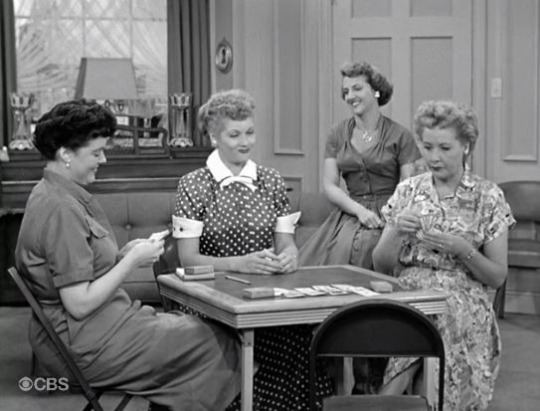
A game of cards in “Lucy Is Matchmaker” (ILL S2;E27) brings out Caroline and Pauline (Peggy Rea).

In “The Camping Trip” (ILL S2;E29), the card game has swapped out Pauline for Sally (June Whitely Taylor).
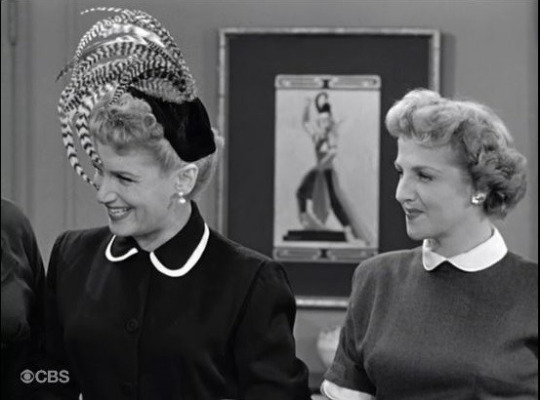
The card game is moved to the Appleby apartment (Chinese Modern) in “Lucy Tells The Truth” (ILL S3;E6), with ‘cackling’ Marion Strong wearing a statement hat!
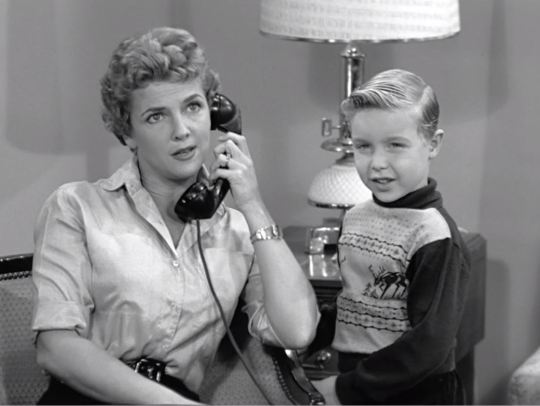
Caroline Appleby with her son Stevie (Steven Kaye), one of Little Ricky’s best friends.

Caroline with her husband, local TV station manager Charlie Appleby (Hy Averback) in “Baby Pictures” (ILL S3;E5) . The next (and last) time we see Charlie Appleby he will be played by George O'Hanlon (inset photo).
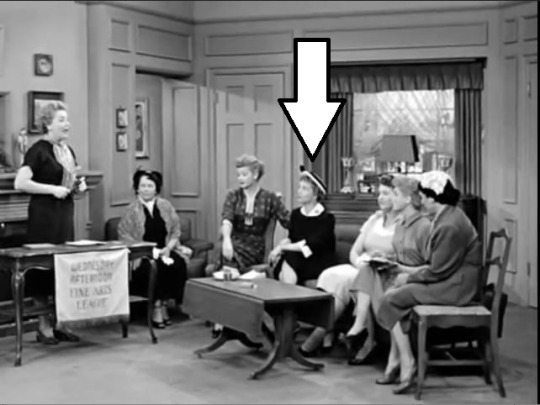
The Wednesday Afternoon Fine Arts League calls an emergency meeting to address the deficit in the budget in “Lucy’s Club Dance” (S3;E25). Caroline Appleby turns up in a black dress with Peter Pan collar and hat!

Visiting Hollywood, Caroline was suddenly near-sighted! To convince Caroline that she was hob-nobbing with celebrities, Lucy and Ethel scheme to get her glasses off her in two related episodes, “The Dancing Star” (ILL S4;E27) and , “Lucy Meets Harpo Marx” (ILL S4;E28).
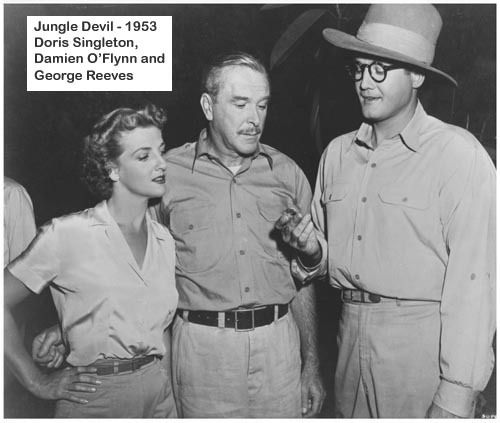
In 1953, Singleton made her television TV debut as Gloria Harper in the episode "Jungle Devil" on “The Adventures of Superman.” Coincidentally, Singleton's final appearance on “I Love Lucy” was in an episode with Superman (George Reeves), "Lucy and Superman" (ILL S6;E4).

In 1966, Singleton was teamed again with Ball on “The Lucy Show” in the episode, "Lucy and Art Linkletter", in which she plays Ruth Cosgrove, an actress whom Linkletter hires to help Lucy with a stunt on his television series. Coincidentally, Ruth Cosgrove is the name of Milton Berle’s real-life wife, who will also guest star on “The Lucy Show” as herself.
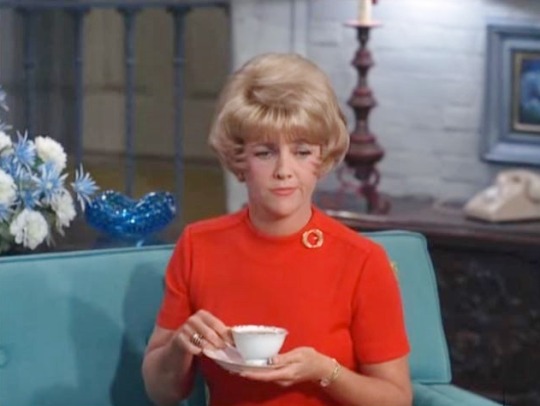
Her second appearance on “The Lucy Show” was in “Lucy Gets Her Diploma” (TLS S6;E5) in 1967. Note: Doris has very little to do with the main plot of this episode. Her one scene might have been originally meant for Mary Jane Croft but reassigned due to a conflict in Croft’s schedule or illness.
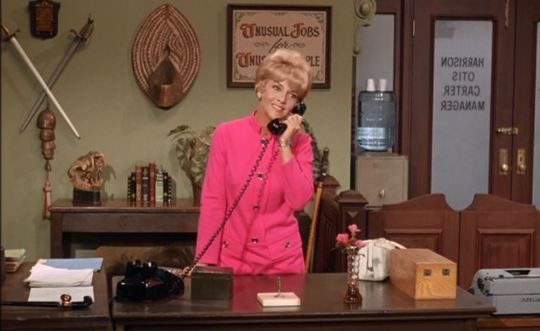
Singleton said that she had originally been hired to be a regular on Ball's third series, “Here's Lucy” in 1968. Ball would have played a dumb secretary and Singleton the more intelligent one, but the premise was dropped when Ball decided to cast her own children in the show. She did, however, appear in the series premiere episode, "Mod, Mod Lucy" (HL S1;E1).

In 1971, Singleton was featured on an episode of ABC sitcom, “Make Room For Granddaddy” which had Lucille Ball as the guest star. In this installment, titled "Lucy Carter, Houseguest", Singleton played Grace Munson, another character from “I Love Lucy,” although she is listed in the credits as Sylvia.

In a 1973 Bob Hope Christmas Special, Lucille Ball, Gary Morton, Hope and Doris Singleton all played themselves in a sketch that finds Lucy believing Bob has a secret crush on her and buying her expensive gifts. Singleton is not given a character name but drops by to Ball’s home.
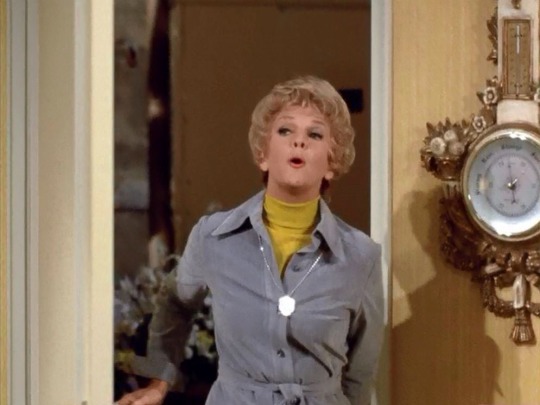
Her final appearance on “Here's Lucy” was as Lucille Ball's studio secretary in "Lucy Carter Meets Lucille Ball" (HL S6;E22) in 1974. Her character was named Doris. (If Lucy was Lucy and Lucille was Lucille, then why shouldn’t Doris be Doris?)

Singleton and Ball were reunited one last time, again as Ball's studio secretary, in the 1980 special “Lucy Moves to NBC.” She played Wanda Clark, who was Lucille Ball’s real-life secretary.
DORIS at DESILU (SANS LUCY)

Singleton did an episode of Desilu’s helicopter series “Whirlybirds” in 1957. She played Jan Revere in an episode titled “Lady Luck.”

In 1954 and 1958 she was at Desilu for two episodes of “The Danny Thomas Show”. In 1958, to symbolize the show’s move to CBS, the Williams family moved into the Ricardo home in Westport. In return, Lucy and Desi guest-starred on “The Danny Thomas Show” as the Ricardos.
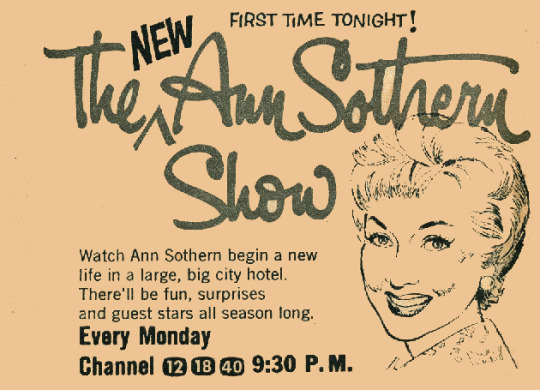
In February 1960, Doris played Mavis on Desilu’s “The Ann Sothern Show” directed by “Lucy’s” James V. Kern. In a 1959 cross-over episode of “The Ann Sothern Show”, Lucille Ball guest starred as Lucy Ricardo.

In 1960, Singleton became a regular character of Desilu’s new series “Angel” about a young woman who has moved to America from France after getting married to her sweetheart, John. Singleton played Susie for 26 of the show’s 33 episodes. It last just one season. Above, Lucille Ball attends a kick-off event featuring Jess Oppenheimer (creator), Annie Fargue (Angel) and Marshall Thopmson (Johnny). Singeton shared the soundstage with “Lucy” alumni Shirley Mitchell, Gale Gordon, Madge Blake, and many others.

In 1960 and 1962 she was back at Desilu for two episodes of “The Real McCoys”.

Singleton was in three episodes of “The Dick Van Dyke Show” between 1962 and 1965.

In Fall 1967, Singleton did a day on “Gomer Pyle: USMC” filmed at Desilu Studios. A year earlier, Gomer Pyle (Jim Nabors) made a cameo appearances on “The Lucy Show” (TLS S5;E9) in which Lucy Carmichael is mistaken for Lou C. Carmichael and drafted!

“My Three Sons” - on which she played two different characters - was filmed on the Desilu backlot. Her first character was Helen Morrison (two episodes in 1964 and 1965), the mother of Sally Ann (Meredith MacRae)—the woman who married the eldest of the Douglas sons, Mike (Tim Considine), and both left the series shortly after the start of the 1965-66 season. Doris was pressed into service again in the 1970-71 season to play the mother (Margaret) of Polly Williams (Ronnie Troup), a girl who also nabbed herself a Douglas boy—this time eloping with youngest son Chip (Stanley Livingston). She played the character for six episodes.
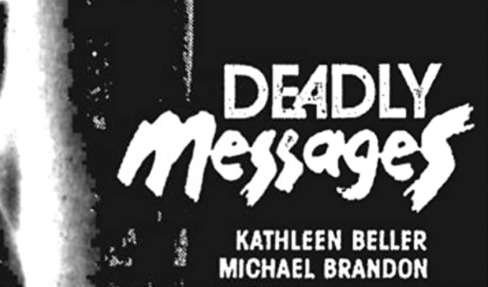
Her final screen appearances was a small role in the ABC TV film Deadly Messages in 1985.
Singleton married Charles Isaacs in 1941, and they remained married until he died on December 13, 2002. She died in 2012, aged 92, from complications of cancer. She had no children and left no immediate survivors.
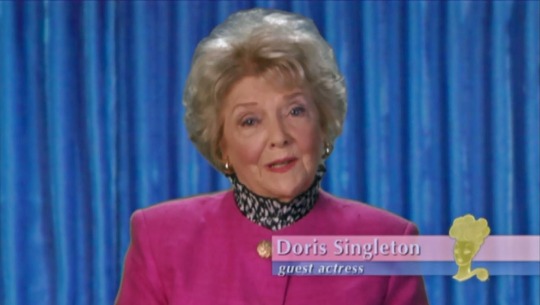
#Doris Singleton#I Love Lucy#The Lucy Show#My Favorite Husband#Caroline Appleby#Here's Lucy#Lucy#TV#My Three Sons#Dick Van Dyke Show#Whirlybirds#Deadly Messages#Lucy Moves to NBC#Bob Hope#Gomer Pyle USMC#The Real McCoys#The Danny Thomas Show#Superman
6 notes
·
View notes
Photo
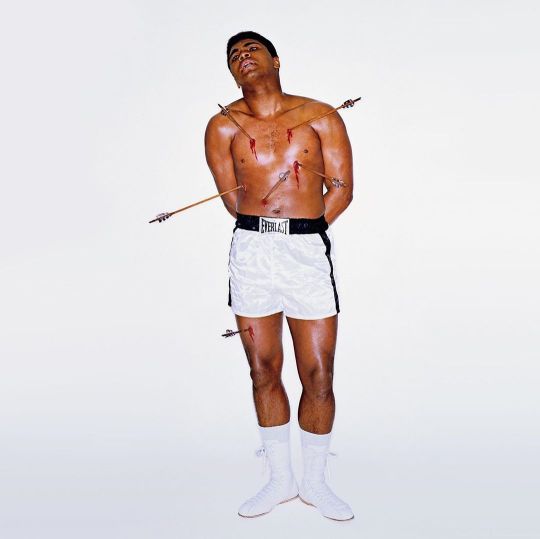
Carl Fischer | Muhammad Ali as San Sebastian | 1967 | Lodging six arrows deep into the body of one of the world’s strongest athletes is no small feat—even if it’s a stunt. Just ask art director George Lois and photographer Carl Fischer, who created one of journalism’s most iconic images in 1967, when they showed champion boxer Muhammad Ali’s glistening chest and thigh seemingly pierced by a volley of sharp bolts.
The photo, which ran as the April 1968 cover of Esquire, shocked readers for many reasons. Not only was the mighty Ali portrayed as fallible—bleeding from six wounds and mouth agape in agony—the image was also loaded with allusions to highly charged events rippling through and dividing America.
Lois and Fischer shot the photo in late 1967, when tensions from the civil rights movement and Vietnam War protests ran high. Ali, then in his mid-twenties, fought for both causes. He’d become a galvanizing example of black triumph after winning the heavyweight championship in 1964. More controversially, though, he refused to be drafted into the Vietnam War—a move that made him myriad enemies across government, sports, publishing, and American homes. Ali had recently converted to Islam, whose holy book, the Qur’an, condemned violence. So when he was called up for induction into the army, in 1967, he attended the ceremony, but didn’t move a muscle when his name was called. “My conscience won’t let me go shoot my brother, or some darker people, or some poor hungry people in the mud for big powerful America,” he explained that year.
In response, Ali was stripped of his heavyweight title, his boxing license was revoked. He was fined $10,000 and later arrested, though he never served time (he was cleared by the U.S. Supreme Court in 1971). Outcast and scapegoated, the boxer’s immense fan base, along with those protesting the seemingly unending war, rallied around their hero fiercely.
It was in this environment that Lois, a thirtysomething former adman helming Esquire’s creative team, received the fateful assignment to conceive a cover featuring Ali. Why not model Ali after one of Christianity’s most well-known, hardest-suffering martyrs, the figure of Saint Sebastian? (at United States of America)
https://www.instagram.com/p/CBYPbUeFbzg/?igshid=1m2l20w1auw7m
7 notes
·
View notes
Photo

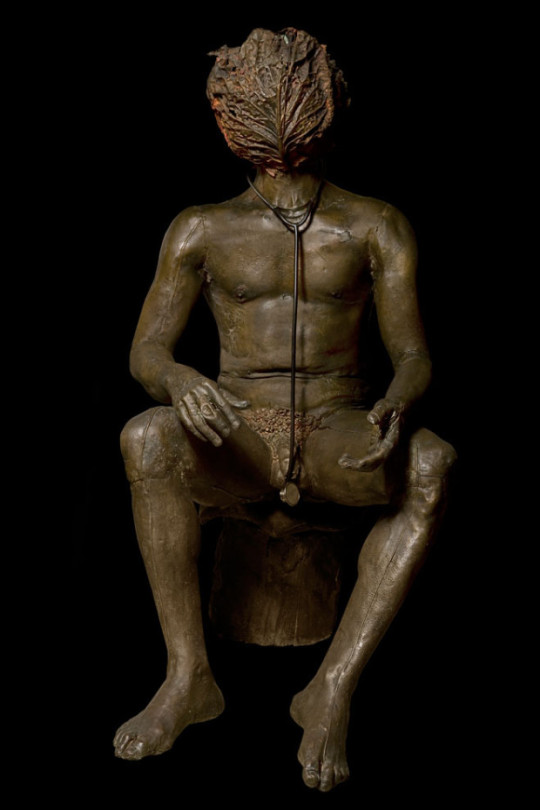



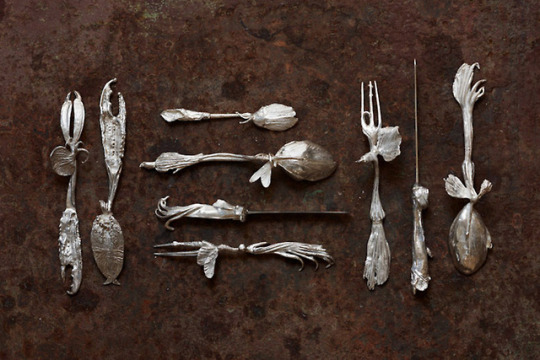
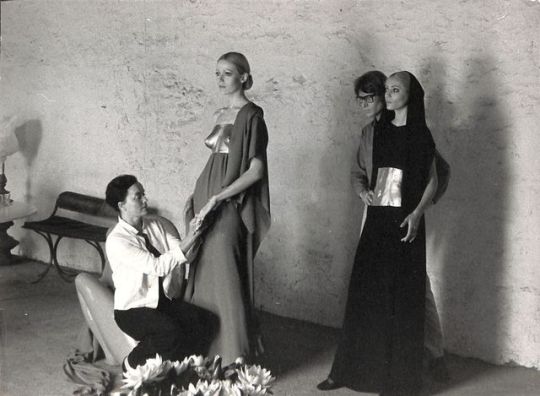
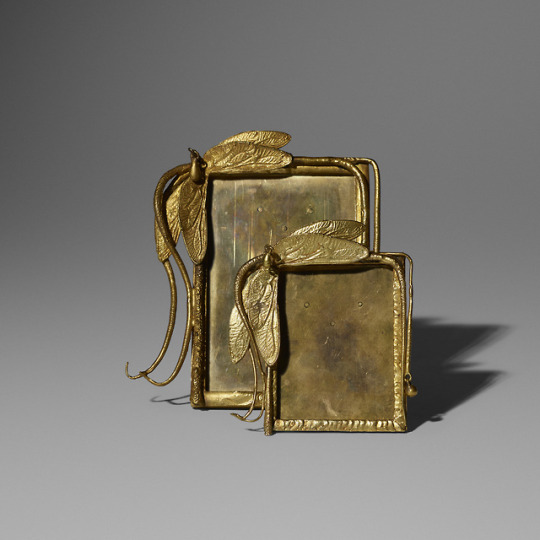

Dame Claude Lalanne (1925 - 10 avril 2019)
Dame Claude Lalanne, the French artist who crafted surrealistic jewelry & sculptures died early Wednesday morning in Fontainebleau, France.
She initially studied architecture before a pivotal encounter with the painter Francois-Xavier Lalanne in 1952, with whom she fell in love and married in 1967. After their marriage, each turned to sculpture as their creative medium of choice, going on to work collaboratively as ‘Les Lalanne’
With her husband, François-Xavier Lalanne, who predeceased her in December 2008, Dame Claude Lalanne was successful with the fashion world, being granted commissions from the likes of Yves Saint Laurent and Pierre Bergé, Hubert de Givenchy and Karl Lagerfel.
While often considered a team, Claude and François-Xavier Lalanne seldom worked together, although their art bore a similar aesthetic. Her creations were often organic in shape, inspired by nature — flora and fauna — whereas his mostly took the form of animals.
Her influence on fashion is ongoing. Ludovic de Saint Sernin’s men’s fall 2019 collection, for instance, included ceramic molds of body parts, nodding to the artist.
“Dimetrodon II” c. 1998, (Collaboration with François-Xavier)
“L'Homme à la tête de chou” (The Man with the Cabbage Head) c. 1968
“Crocodile Armchair” c. 2016,
“Choupatte” (very big) c. 2008-2012, Image courtesy Ben Brown
“Ginkgo Chair II” c. 2018, Courtesy Ben Brown Fine Arts
Cutlery Model made for Alexandre Iolas, c. 1966. Photo by Alexandre Baillache
Yves Saint Laurent, Claude Lalanne and models wearing the Haute Couture A/W69 collection with sculpted busts and waists by Claude Lalanne
“Frames,” Artcurial, c. 1990 (Courtesy Wright Auction House)
“Collerette” Earrings c. 1980-1989 (Sotheby’s)
#art#sculpture#poetry#surreal#claude lalanne#lalanne#francois-xavier lalanne#yves saint laurent#karl lagerfeld#ceramics#jewellery#fashion#crocodile#armchair#ginkgo#dimetrodon#cabbage#cuterly#earrings#organic#alexandre iolas#choupatte#wright#ben brown#humour
339 notes
·
View notes
Text
An Eye For Paul, And More
May 31, 2011- Los Angeles Times; By Liesl Bradner
A new book features images from her days as a rock 'n' roll photographer — and beyond.
Linda McCartney may have married a Beatle, but it was the Rolling Stones who gave the budding photographer her big break. It was 1966, while working as a receptionist in Manhattan, that Linda Eastman, as she was known then, wangled her way aboard a yacht on the Hudson River, a publicity event for the Stones. Soon she was embedded in the late-'60s rock 'n' roll scene, photographing her future husband, Paul McCartney, at a "Sgt. Pepper's Lonely Hearts Club Band" album launch party in 1967.
Thirteen years after her death, Paul McCartney and their children, with editor Alison Castle, have selected more than 300 photos from her archive of 200,000 images to produce "Linda McCartney: Life in Photographs" (Taschen, $69.99).
The 288-page tome is not only an intimate peek at family life with the McCartneys, playing and relaxing at their homes in Scotland, London and Arizona, but also a scrapbook of candid, behind-the-scenes shots of such figures and performers as the Doors, Willem de Kooning, Jimi Hendrix, Janis Joplin, Tim Buckley, Michael Jackson and Johnny Depp.
"She had a knack for blending in, making people feel unguarded and not being intimidated by her," said her daughter Mary on a recent trip to Los Angeles. Mary, also a photographer, published her own book of photographs last fall, "Mary McCartney: From Where I Stand" (Abrams, $35). "I try to take the same informal approach, getting the trust of your sitter and working as a team," she said.
A rarely seen image of a yawning Hendrix backstage in 1967 demonstrates the casual, spontaneous shots for which Linda became famous. "It's quite surprising and funny," said Mary McCartney. "People don't usually see photos of him so relaxed."
Some say it was the presence of a pretty, blond woman behind the lens that put her subjects at ease. Women photographers were not as common as they are today, especially in the music industry. So it was a well-earned distinction when Linda McCartney became the first female photographer to have her work featured on the cover of Rolling Stone, with her portrait of Eric Clapton on May 11, 1968, issue.
The eldest daughter from a well-to-do Scarsdale, N.Y., family, Linda McCartney briefly studied photography in the 1960s at Tucson's Art Center under the tutelage of Hazel Archer.
"She was inspired by the natural light in Arizona and the American Indian portraits by Edward Curtis," said Mary McCartney, who also noted that her mother was influenced by the gritty beauty of images by Dorothea Lange, Alfred Stieglitz, Edward Steichen and Ansel Adams.
She stopped taking pictures professionally in the '70s when she had her family. "We became her subjects," said Mary McCartney, "We took it for granted a camera always being in our face." Those personal, tender images reflect happy, normal family moments, Paul and son James laughing in a tub immersed in bubbles or Paul in his bathrobe with the kids on their farm in Scotland.
The foreword is written by Paul along with text and insights from daughters, Stella, a fashion designer, and Mary, Annie Leibovitz, and art historian Martin Harrison.
"She found her confidence in rock 'n' roll. She had a real interest in her subjects and that passion comes through," said Mary McCartney. "She was doing it [photography] because it made her feel complete."
4 notes
·
View notes
Photo


UARIZONA MOON RESEARCHERS HELPED NASA NAIL APOLLO 12 PINPOINT LANDING The Eagle swooped over the craggy, monochromatic terrain, keenly searching for a smooth landing place. Nothing but an unwelcoming host of craters and boulders streamed below. Pushing its limits, it flew on. The Apollo 11 lunar module touched down in the Sea of Tranquility, in what could be considered one of the greatest human accomplishments. But with its fuel nearly drained, the Eagle landed nearly four miles from the intended landing site. During the next mission, NASA sought to demonstrate a pinpoint landing with “Intrepid,” the lunar module of the Apollo 12 mission, which launched 50 years ago on Nov. 14, 1969. Five days later, two Apollo 12 astronauts -- Pete Conrad and Alan Bean -- climbed out of Intrepid. They were only 600 feet (about two football fields) from their target location -- the landing site of lunar lander Surveyor 3. The feat was accomplished thanks to the work of University of Arizona planetary scientist Ewen Whitaker and a team led by Gerard Kuiper, the father of modern-day planetary science and founder of the Lunar and Planetary Laboratory. Finding Surveyor 3 When President John F. Kennedy announced in 1961 that Americans would walk on the surface of the Moon by the decade’s end, Whitaker, Kuiper and their team were already imaging and mapping the lunar surface. Their efforts to produce the first photographic lunar atlases of the Moon and their partnerships with the university’s geology department and the astrogeology branch of the United States Geological Survey gave them a deep understanding of the Moon’s geology and geography. As a result, the team played a key role in the series of robotic spacecraft that visited the Moon ahead of the Apollo missions. Surveyor 1, the first of seven unmanned lunar landers in a program that ran from June 1966 through January 1968, reached the surface of the Moon on June 2, 1966, and sent back panoramic photos from its travels. Surveyor 1’s success reassured the astronauts they would not be swallowed by dust. When NASA published what they thought was Surveyor 1’s correct landing site in the journal Science, Whitaker disagreed. He demonstrated his peerless prowess of lunar geography when he correctly identified Surveyor 1’s landing site after poring over images taken by the Lunar Orbiter and matching lunar features in photos with Moon maps. Whitaker published the alternate location in the September issue of Science. His skills earned him the task of locating four more Surveyor landing sites, including Surveyor 3, which landed on the Moon in the western Oceanus Procellarum (Ocean of Storms) on April 20, 1967. To demonstrate a pinpoint landing with Apollo 12, NASA used Whitaker’s location of Surveyor 3 as the target. The location also gave the crew a chance to return parts of the robotic explorer Surveyor 3, which had been on the Moon since 1967, for assessment after more than two years in space. Finding Surveyor 3 was more difficult than Surveyor 1 because Surveyor 3 had landed in a crater, meaning there were limited landmarks to rely upon. “I’m sure Ewen Whitaker was holding his breath as the astronauts climbed out of the lunar module,” said Jim Scotti, an astronomer with SPACEWATCH, the UArizona group dedicated to detecting near-Earth objects. “Surveyor 3 had been in darkness as the lunar module came in for a landing.” Whitaker’s location was so spot on that the astronauts were able to walk to Surveyor 3. “The iconic image, for me, of Apollo 12 is the astronaut Pete Conrad standing by Surveyor 3 with the lunar lander in the background,” said Tim Swindle, director of the UArizona Lunar and Planetary Laboratory. Meeting Alan Bean Scotti has often joked that by becoming a space artist, astronaut Alan Bean, who snapped that iconic image, made up for damaging the sensors of the first color television camera on the Moon’s surface when he accidentally pointed it toward the Sun. Luckily, becoming an artist also brought Bean to Tucson -- a hub for space art -- where he met Whitaker about 30 years after leaving the Moon. Scotti, a space artist himself, was there to witness the first meeting of the two people responsible for the success of Apollo 12. “Ewen Whitaker and I were in line together to meet Alan Bean,” Scotti said. “He had brought photographs that he used to find Surveyor and was going to ask Bean to sign them. When he eventually did, it was like watching two best friends chatting back and forth like they’d known each other for years.”
1 note
·
View note
